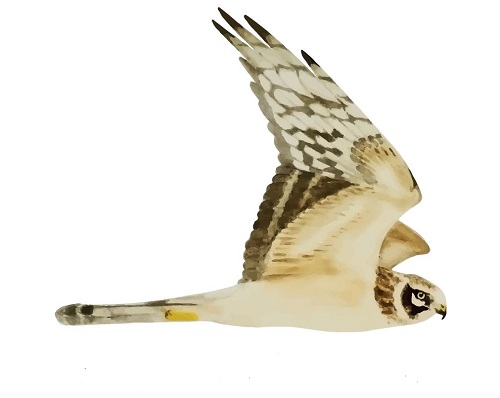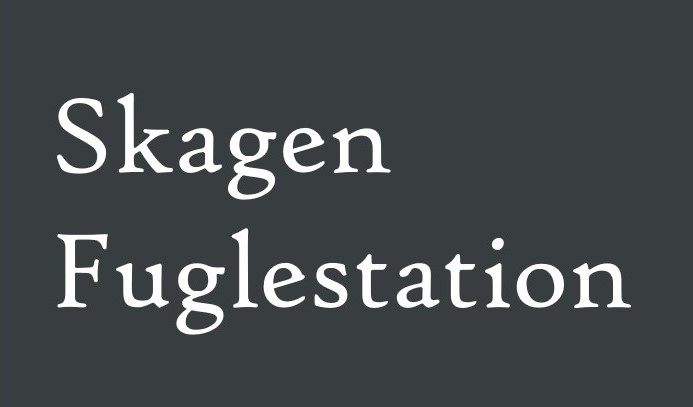Her på Skagen Fuglestations blog bringes korte nyheder i dagbogsformat om hændelser på fuglestationen.
Birds & Landscape
The morning started well when I heard a Kingfisher (Isfugl) west of the Sandormen tracks on my way to Worlds End III. After arriving at the observation site, Sarah and I were soon greeted by a beautiful Goldeneye (Hvinan) flying nearby. Of all the species at sea, this beautiful sighting was probably one of the highlights. After that, there wasn't much movement. Things went better for passerines in terms of numbers. Increasing numbers of arriving songbirds were fun to count. It was the first day we reached the threshold of 100 arriving meadow pipits from the sea. These numbers are likely to rise significantly in the coming weeks, but we have already had a nice taste of what is to come. I tried all the time to find a rarer bunting among the many resting and attempting to migrate Reed Buntings (Rørspurv). Therefore, I also photographed as many flying birds as possible. So far, nothing rare has turned up, but I hope that one day, if I keep doing this long enough, I will get a record shot of a top rarity this way ;)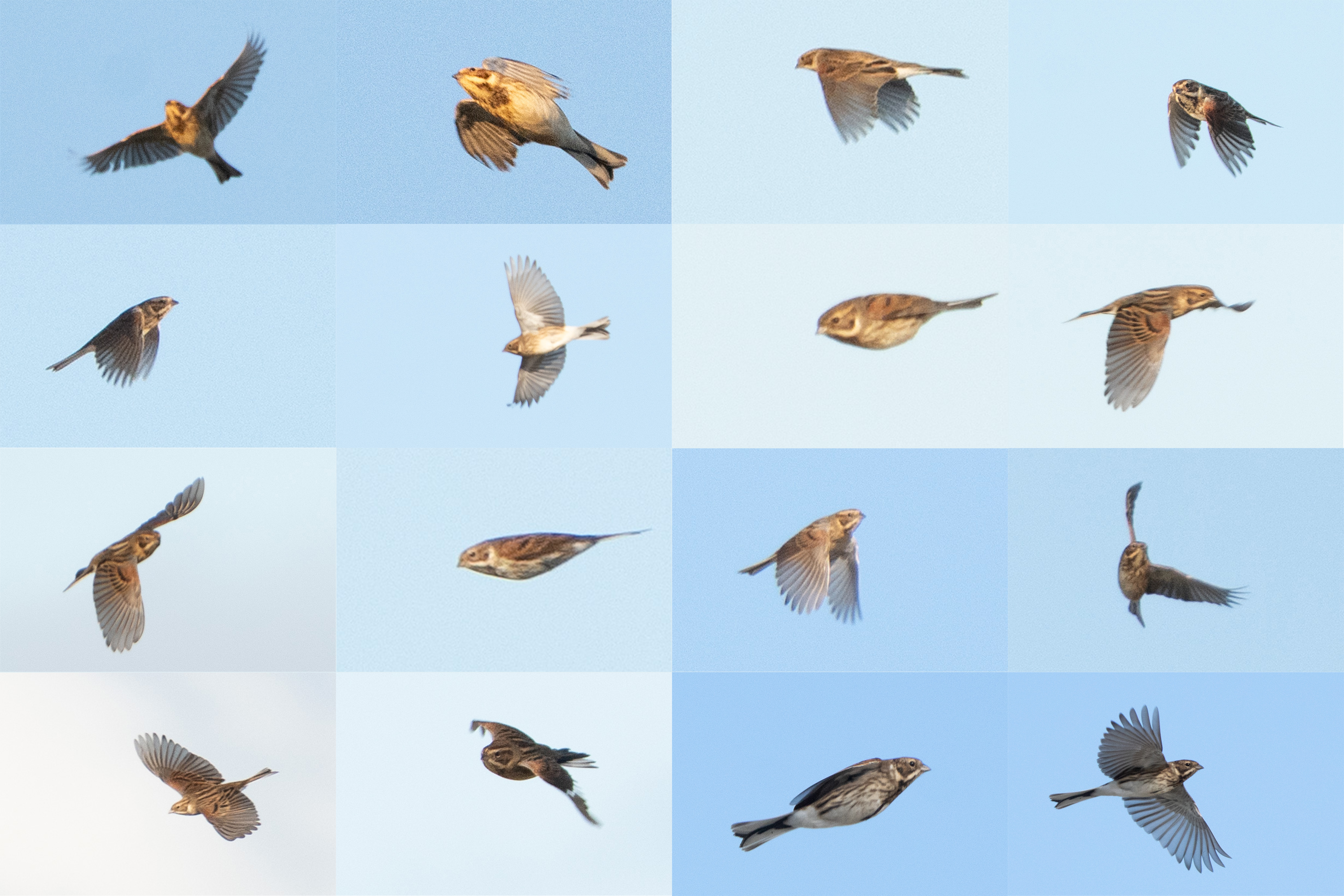
A small part of todays Reed Buntings (Rørspurv)
Simon made a nice sighting today when he spotted a Great Grey Shrike (Stor Tornskade) from Kabeltromlen. Due to the wind, not all nets were open again, so today 15 new catches and 12 recaptures ended up in the net. The highlight for the ringers, Gabriel, Miles and Amira, were two Blackbirds (Solsort), a beautiful adult male and a very young individual.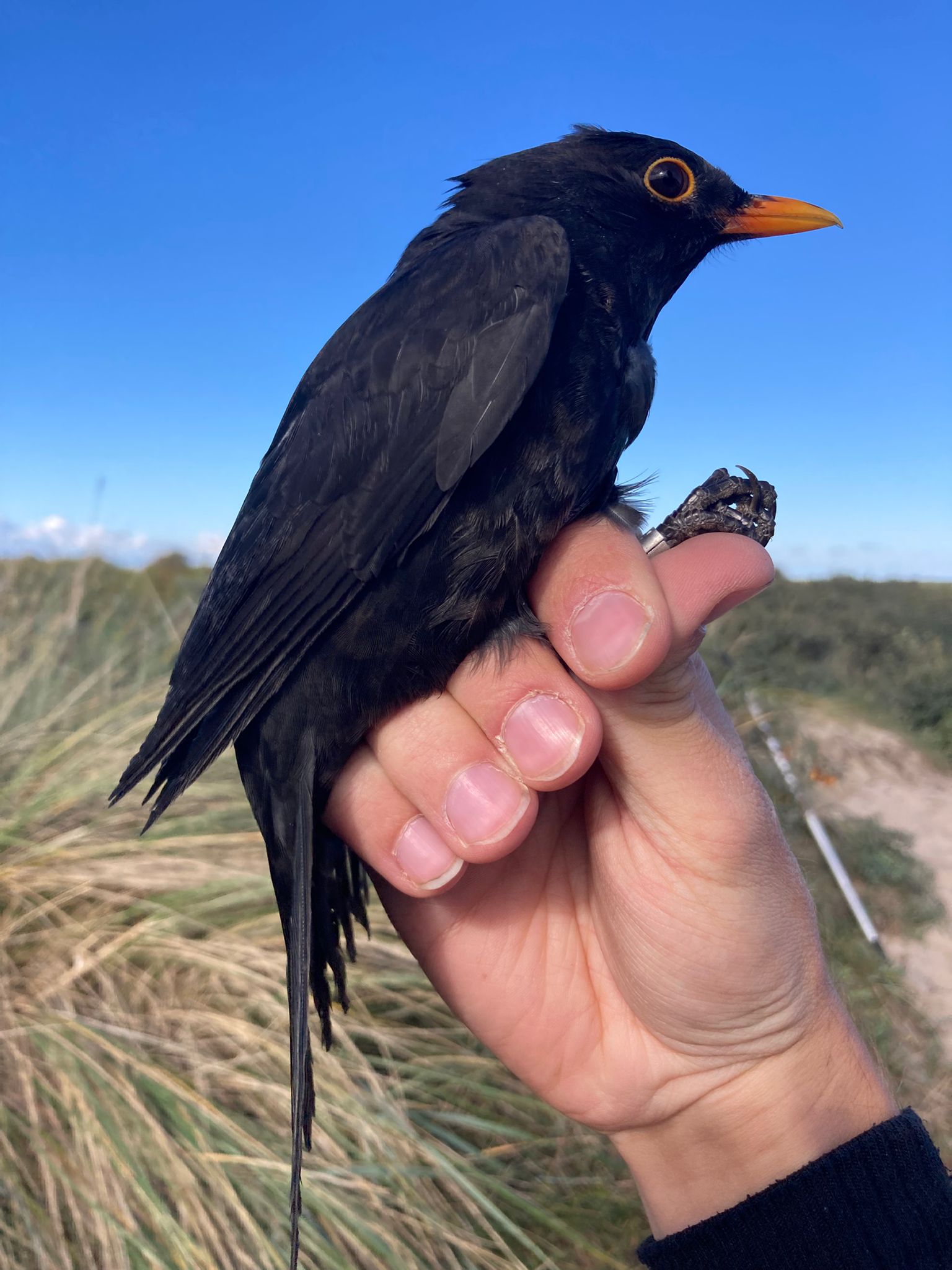
Beautiful Blackbird (Solsort) Male
In the afternoon, we all went on an outing to the large migrating sand dune Råbjerg Mile. Of course, we also took the opportunity to do a lot of birding in the surrounding area. About a dozen Stonechats (Sortstrubet Bynkefugl), two Hen Harriers (Blå Kærhøg) and a very close flock of Red Crossbills (Lille Korsnæb) were really nice to see. But the fantastic forest, the heathland and, of course, the dunes were probably the most impressive highlights.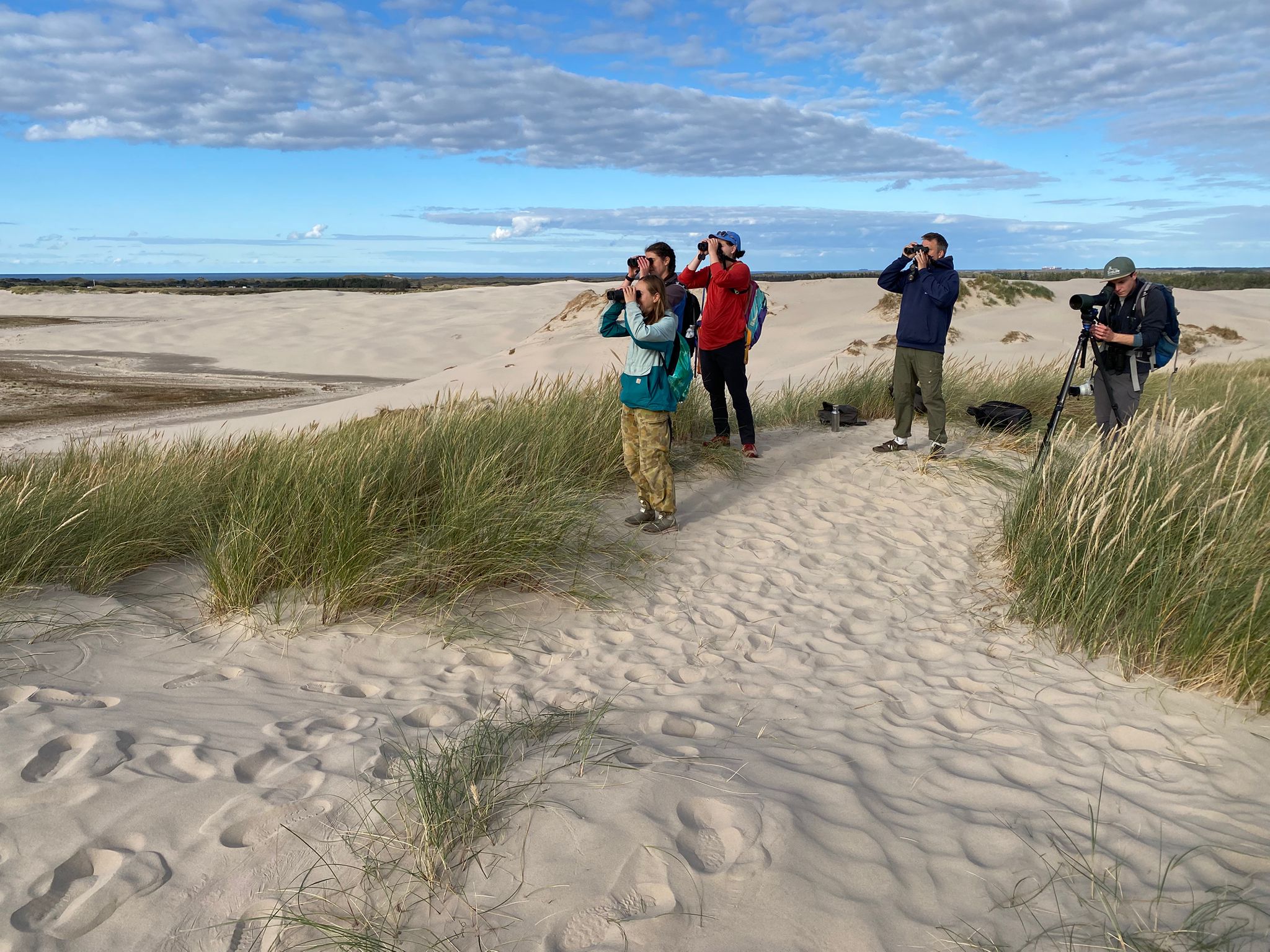
Birding on Råbjerg Mile
Ringing (Kabeltromlen)
Solsort 1
Rødhals 1
Munk 2
Fuglekonge 8
Blåmejse 1
Gransanger 2
Total 15
Highlights from today's observations
Gråstrubet Lappedykker 1
Hvinand 1
Isfugl (Sandormen Track) 1
Today's observations from the area can be seen here.
People: Gabriel Axelsson, Florian Hatt, Sarah Partridge, Amira Nuseibeh, Miles Scheuering, Simon S. Christiansen and our guest Otto Clemmensen.
Nå is a very useful word
This morning was a little windy when Amira and I went to open the nets at Kabeltromlen, so after some deliberation we left closed the six windiest nets. Simon joined us shortly after, and while it was slow he told us about how our ringing data is being used by the ringing centre. Even when there weren’t many birds to ring, there was plenty to look at, with flocks of crossbills (Lille korsnæb), a rough-legged buzzard (fjeldvåge), and one sooty shearwater (sodfarvet skråpe, also known as the king of migration; please pay them your respect) called out from World’s End III. Our highlight from ringing today was a gorgeous adult male Lille gråsisken (Lesser redpoll), who Amira and I fawned over for a few minutes. Then Miles and Florian joined us after the count for the last couple of rounds. We were also joined by some very lovely and enthusiastic tourists who were excited about the birds. We also had a good amount of fuglekonge (goldcrests), two sangdrossel (song thrushes) and my favourite, one træløber (treecreeper); I was glad Florian got to see the treecreeper because he loves cute round birds, and treecreepers are exceptionally cute and round. They have specialized central tail feathers with extra-strong rachis, which are essential for clinging to the trees and balancing as they climb. This is why we see them sitting comfortably in a vertical position on tree trunks, which other species without such tail feathers cannot achieve.
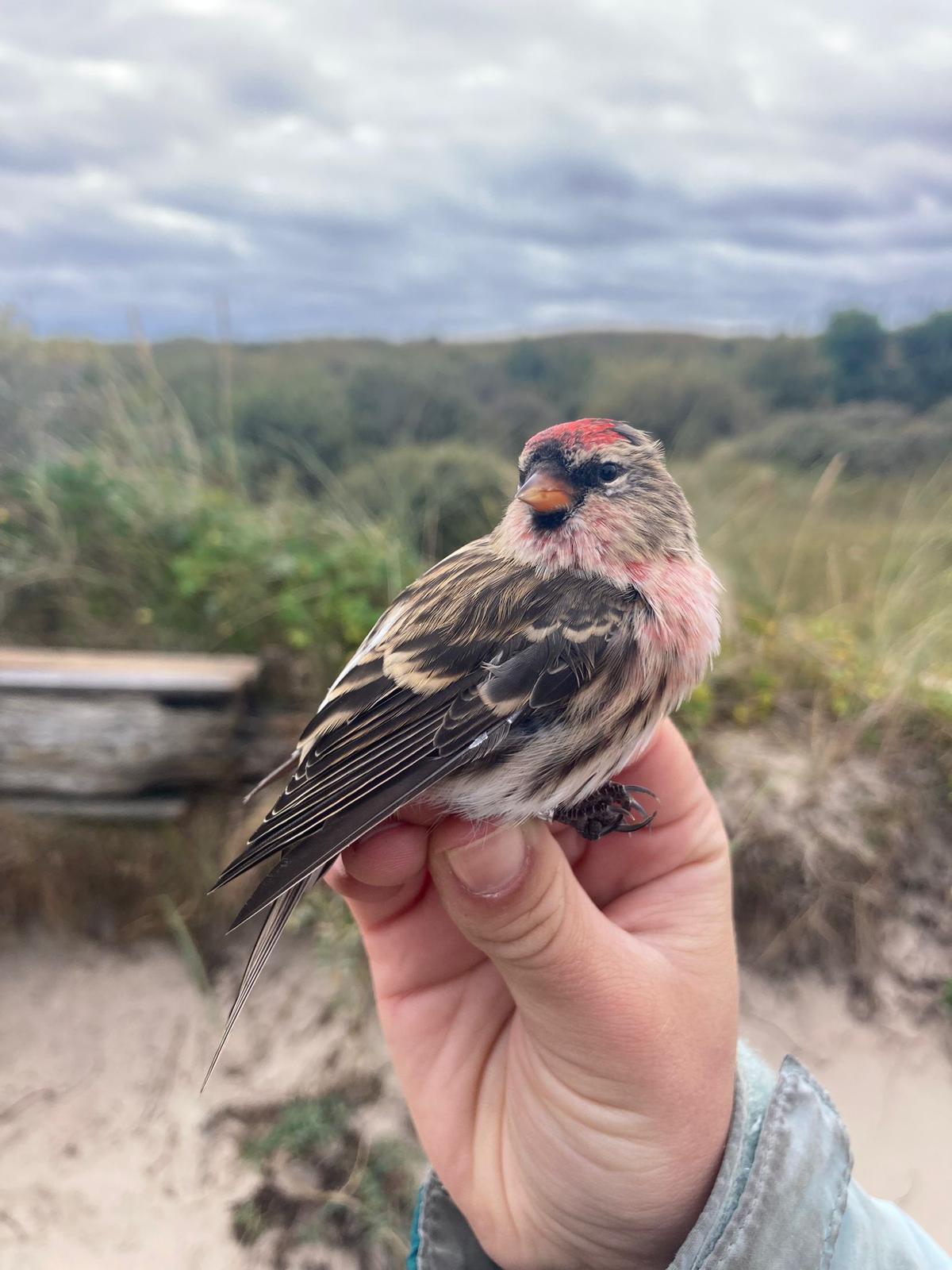
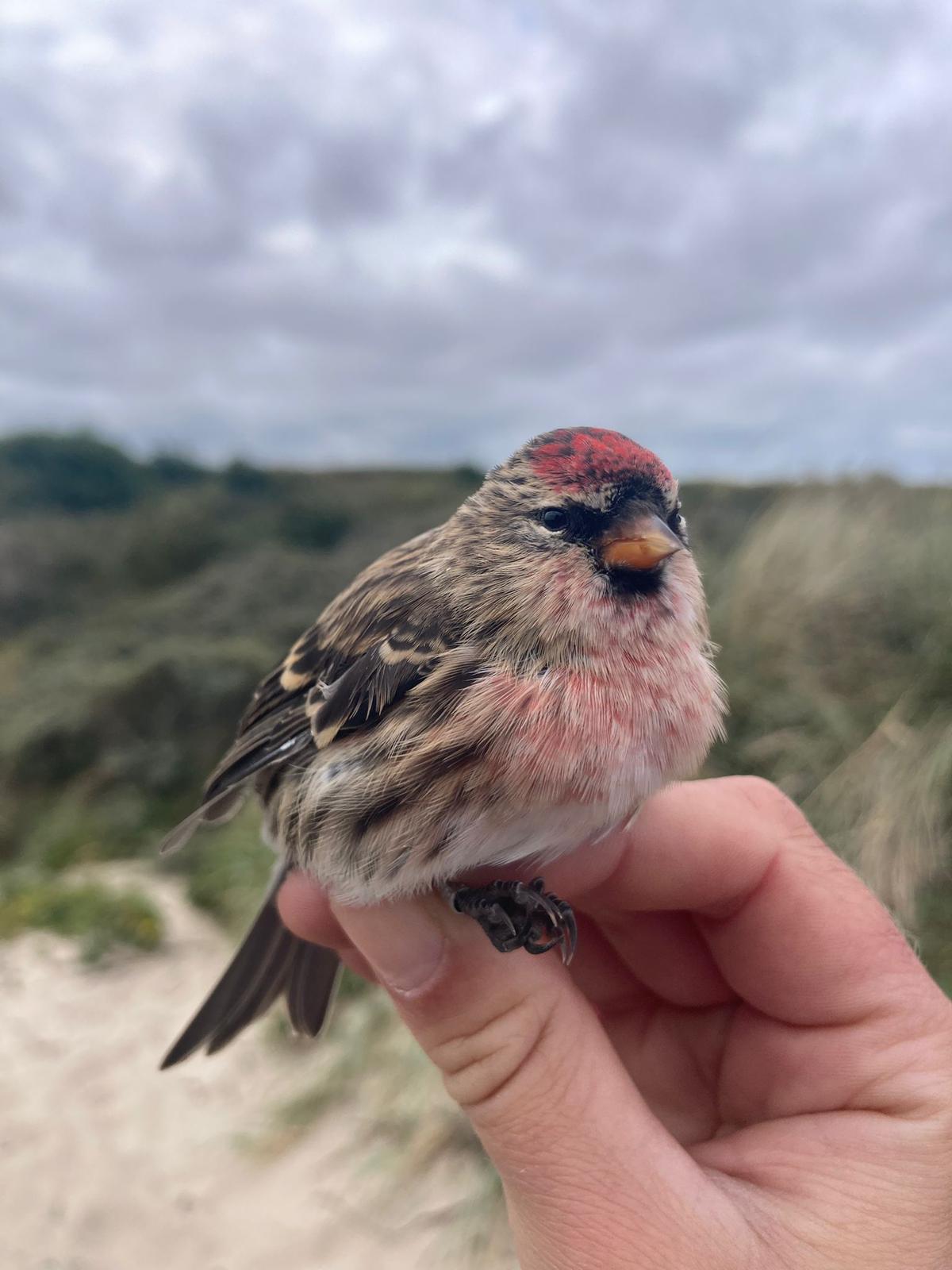
Handsome gentleman indeed
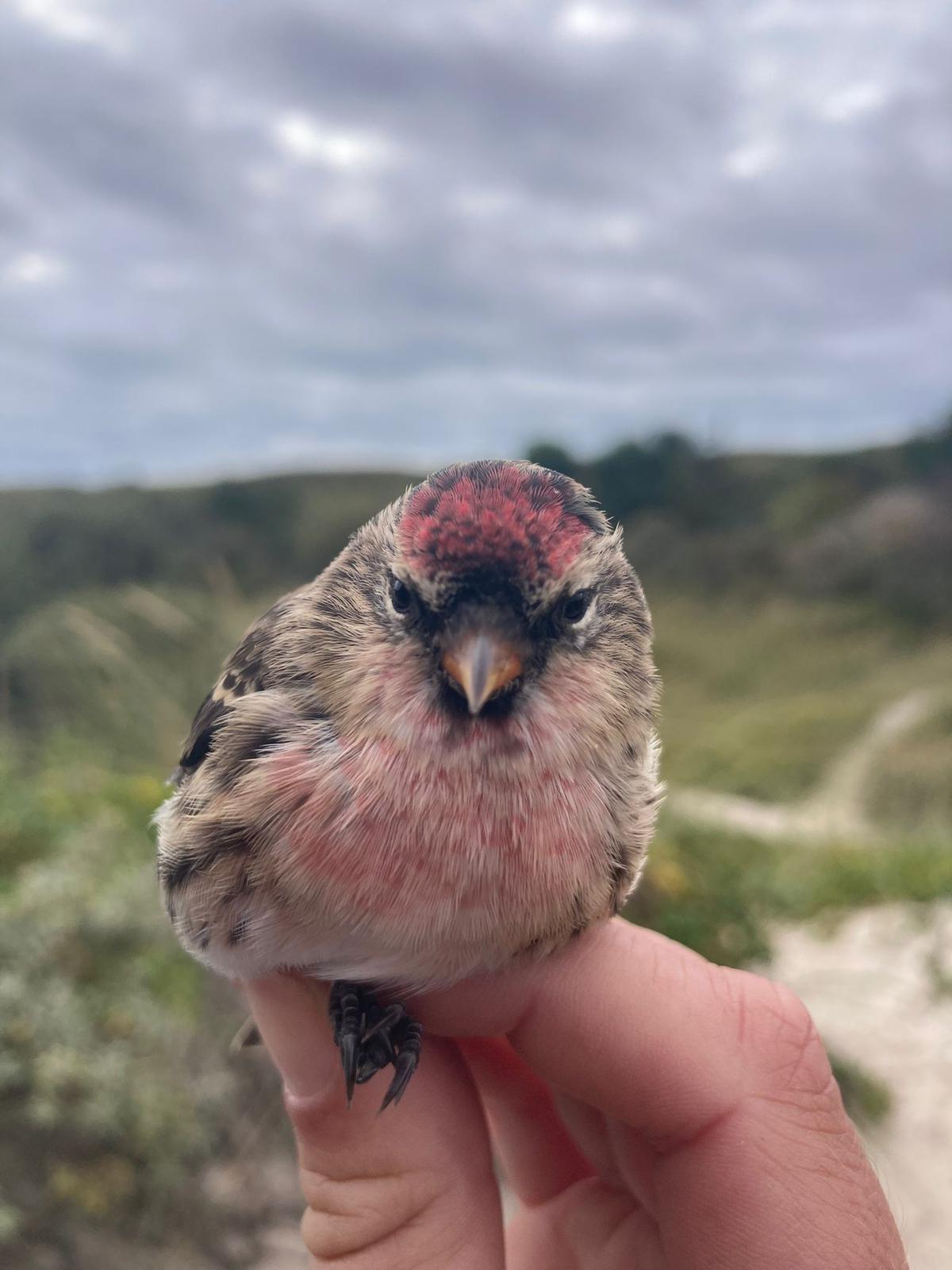
Nå, very handsome
Miles, Florian and Gabriel went to World’s End III for the migration count this morning, which was a little windier and colder than we had at sheltered Kabeltromlen. Their highlights included the sooty shearwater (sodfarvet skråpe), one tufted duck (troldand), and two Arctic Loons (Sortstrubet lom). Gabriel was happy to be able to pick out a Kaspisk måge (Caspian gull) from the flock; he informs me that they are cleaner than Herring gulls (sølvmåge). Nå.
After ringing I shared my wisdom with the others in a short lesson on sewing nets, and then we closed up and headed home. We went our separate ways in the afternoon; Mira, Miles and I went to the shops while Florian went birdwatching at Skarvsøen. There he saw the first great grey shrike (stor tornskade) of the season.
When we came back for evening meeting, we were given a brief lesson on the myriad meanings of the colourful Danish word “nå,” so I will now be using this often, although I suspect there is still much more to learn about this word. I also gave Gabriel a quick lesson on semicolon usage; this is why the blog is filled with them today. Now Amria cooks for us a delicious dinner of more fish cakes, because yesterday Matilde from Blink kindly gifted us a very large quantity of fish (which is extremely delicious; thank you Matilde!).
Today’s Ringing at Kabeltromlen:
Solsort 1
Sangdrossel 2
Gærdesmutte 7
Rødhals 1
Munk 3
Blåmejse 12
Fuglekonge 13
Gransanger 4
Træløber 1
Total new birds: 44
Highlights from World’s End III
Sodfarvet skråpe 1
Troldand 1
Toppet Skallesluger 7
Sortstrubet Lom 2
Kaspisk Måge 3
Today's observations from the area can be seen here.
People: Gabriel Axelsson, Florian Hatt, Sarah Partridge, Amira Nuseibeh, Miles Scheuering, Simon S. Christiansen, Knud Pedersen and our guest Otto Clemmensen.
What Day Is It Today?
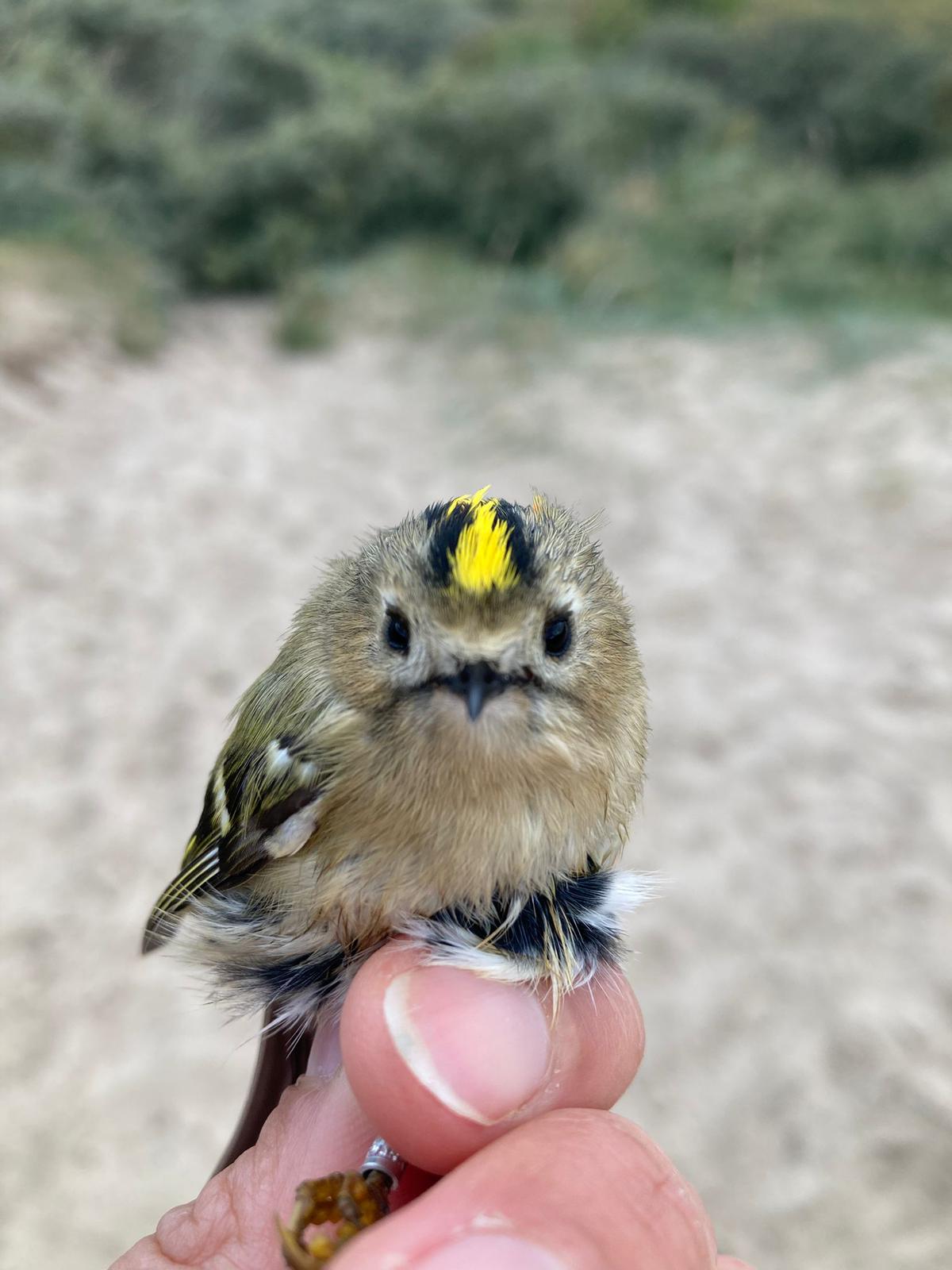
People:
People: Gabriel Axelsson, Florian Hatt, Sarah Partridge, Amira Nuseibeh, Miles Scheuering, Simon S. Christiansen, Lisa Vergin and our guest Otto.
We should protect the birds on their journey
This morning I went with Florian and Miles to World’s End III for observation, and it was a little cold and windy. There was wind coming from the southeast and not too much migration to look at. We saw three Almindelig Kjove (Arctic Skuas) which was nice, and also many Fløjlsand (Velvet scoters) migrating. There were also many Alk and Lomvie (Razorbills and Guillemots), migrating equally in both directions. Where are they going? They will overwinter at sea, except for some who will return to the colonies as early as October. The juveniles left the safety of their nests this July while still flightless, jumping off the cliffs and bouncing down the rocks into the raging sea amidst the screams of their parents and peers, then swimming for dear life after their fathers into the open ocean. What a spectacle to behold!! The wee babies disperse by swimming until around this time, when their flight feathers finally grow in. The adults are similarly flightless for about 40-50 days as they moult all their flight feathers simultaneously while at sea. The ones we see passing by Skagen have already grown their new feathers, and they are headed out to shallow seas to find food until it is time for breeding again. Always a treat to see these cuties cruising by or resting in the waves.
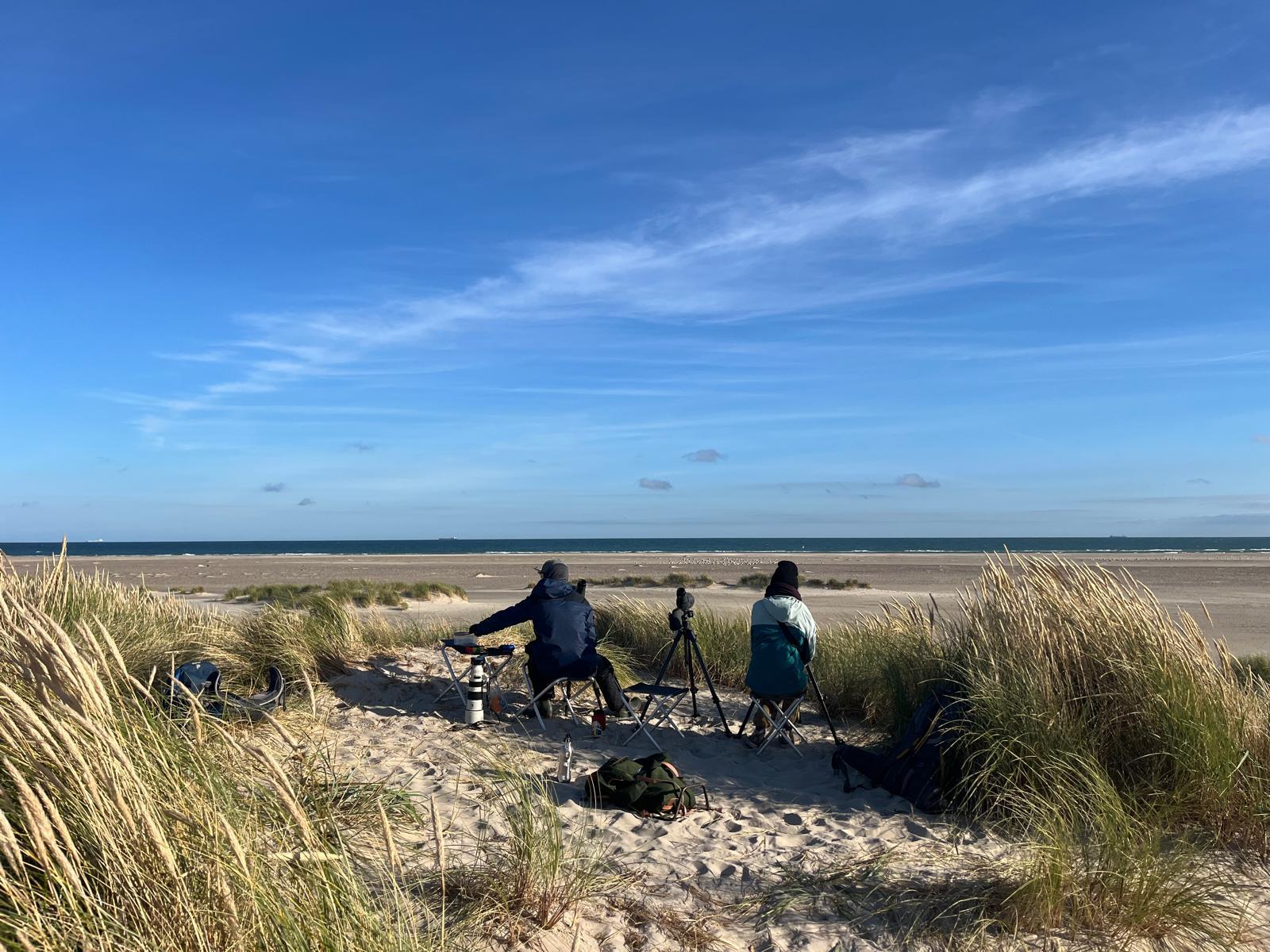
Meanwhile, Gabriel and Amira were ringing at Kabeltromlen, where it was a bit too windy to have all of the nets open. Still, they caught some birds, with highlights including sangdrossel (Song thrush) and Landsvale (barn swallow). Miles joined them for the last round after we finished the count, while I unsuccessfully searched for gull rings.
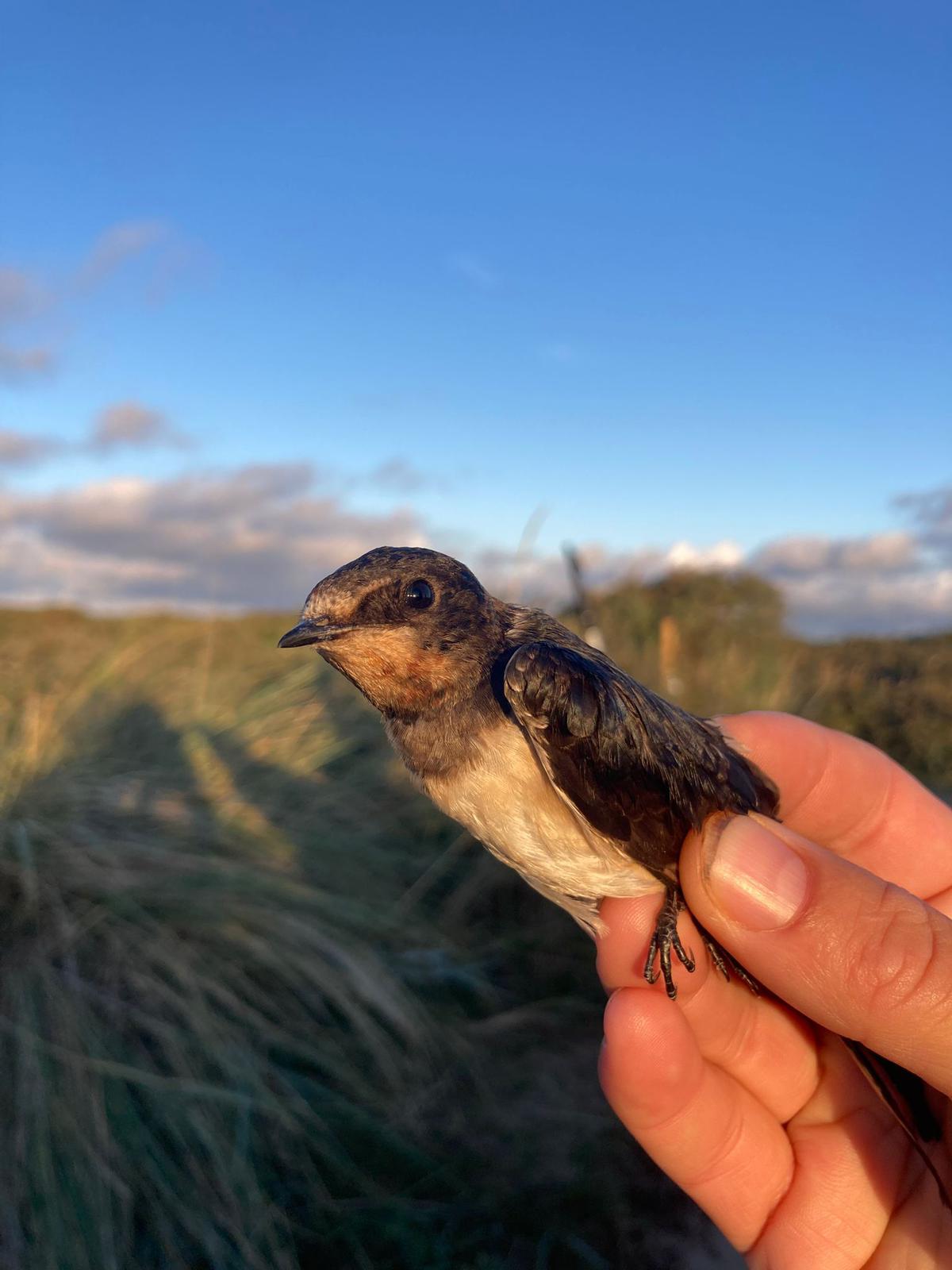
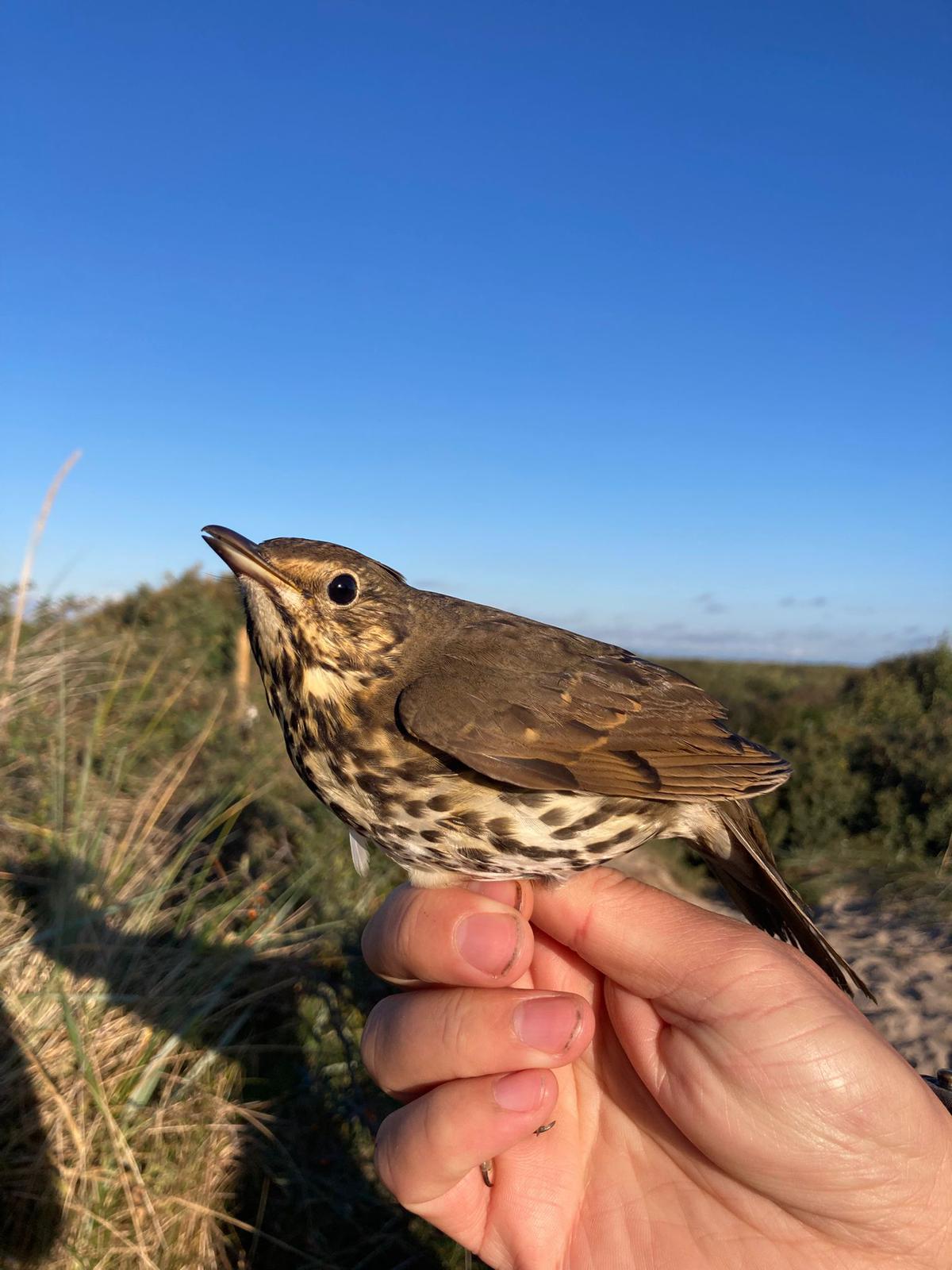
In the afternoon, running club and swim club both took place, followed by late lunch. Then we all cleaned up the flat while listening to some music together. After some office tasks, we will now enjoy the sunset on top of the tower together before dinner. The lighthouse lightbulb is roughly the same size as an ostrich egg.
Ringing at Kabeltromlen:
Sangdrossel 1
Landsvale 1
Grønsisken 1
Træløber 2
Fuglekonge 11
Lille Dompap 2
Rørspurv 1
Rødhals 2
Gærdesmutte 1
Blåmejse 1
Munk 3
Total new birds: 26
Highlights from World’s End III:
Almindelig Kjove 3
Fløjlsand 40
Dværgfalk 1
Fiskehejre 1
Today's observations from the area can be viewed here.
People: Gabriel Axelsson, Florian Hatt, Miles Scheuering, Amira Nuseibeh, Sarah Partridge, Simon S. Christiansen
Ring Ring
Another day with only very little wind was ahead of us. Perfect conditions for ringing, a bit less so for seawatching. Nevertheless, Sarah and I headed to Worlds End 3 in high motivation. The first hour was again dominated by many passerines, most of them coming from inland and turning back before reaching the sea. Soon after the passerine migration quickly slowed down, but instead, we found some nice birds out at sea. A total of five Skuas (Kjove) appeared, three of which we were able to identify as Arctic skuas (Almindelig Kjove). Black Guillemots (Tejst), Red-necked Grebes (Gråstrubet Lappedykker) and Great White Egrets (Sølvhejre), three of each, were also very nice sightings.
Meanwhile, the others had a successful day at Kabeltromlen. In one ouf the net checking rounds, they saw a black thrush in the nets and naturally thought it was a Blackbird (Solsort) at first. But this bird had light-coloured edges on many of its feathers. Something in the ringer’s head went ring ring – it was of course a Ring Ouzel (Ringdrossel), which the ringers then ringed of course with a ring. What a nice capture!
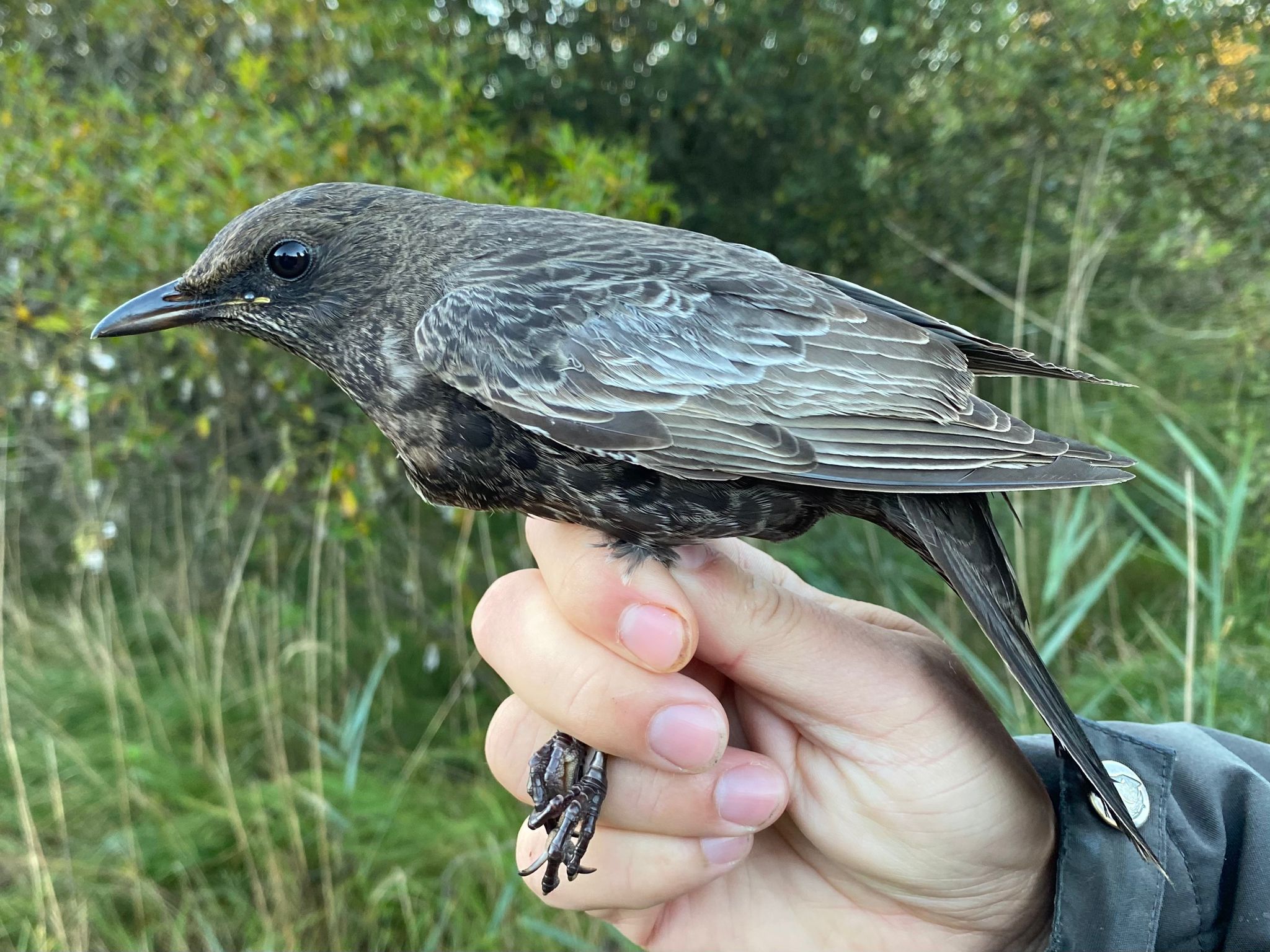
Beautiful Ring Ouzel (Ringdrossel)
To everyone's delight, good numbers of Goldcrests (Fuglekonge), Treecrepers (Træløber) and Wrens (Gærdesmutte) went into the nets, some of the cutest species we catch here!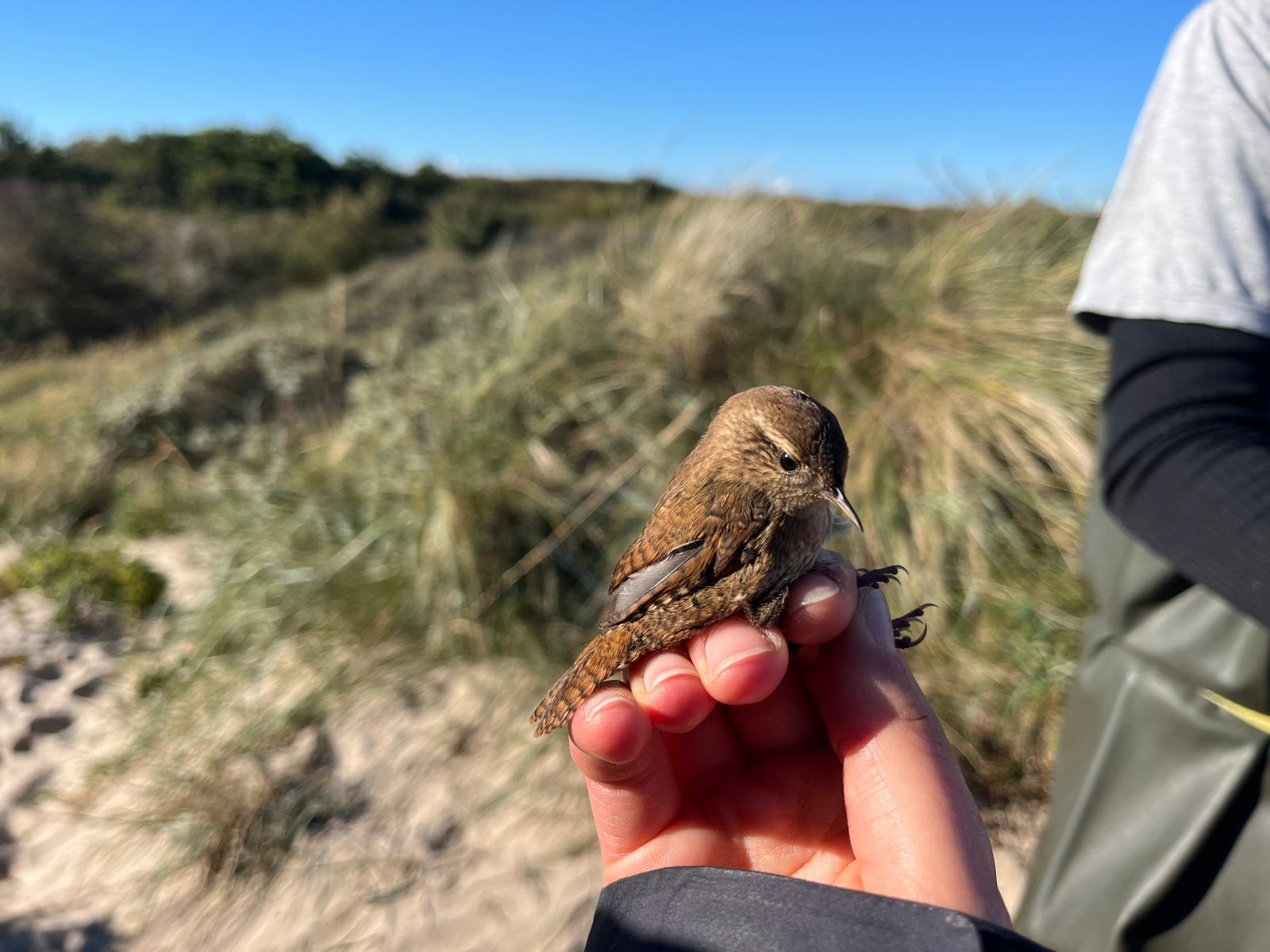
Wren (Gærdesmutte), just very cute!
In the afternoon, some took a nap, others went jogging or took a swim in the sea. Afterwards, we all went into town together to eat cake. On the way back, Gabriel and I checked some bushes and woods for rare warblers, but without success.
For dinner, Amira made us delicious Mexican-style wraps. We only realised later that this was in keeping with Taco Friday, as it is known in Sweden. We wondered why it is called that, because what is eaten in Sweden on this day does not look like real tacos. Nevertheless, our meal was very tasty!
Ringing (Kabeltromlen):
Gærdesmutte 5
Bogfinke 2
Rødhals 1
Træløber 1
Rørspurv 9
Blåmejse 1
Sortmejse 1
Gransanger 6
Fuglekonge 15
Ringdrossel 1
Total: 42
Highlights from Worlds End III
Almindelig Kjove 3
Sølvhejre 3
Tejst 3
Gråstrubet Lappedykker 3
List of today's observations in DOFbasen from the Skagen area
People: Gabriel Axelsson, Florian Hatt, Miles Scheuering, Amira Nuseibeh, Sarah Partridge, Simon S. Christiansen and our guests Ole and Birgitte Jørgensen
Waterbirds Galore
This morning Sarah, Amira, and Florian went out to Kabeltromlen for the ringing. It was Florian’s first time ringing, but he manifested a Common Kingfisher (Isfugl) on the second net run! On the same net run, Amira found a Water Rail (Vandrikse) in a net! It almost escaped, but she was able to grab it just in time! Gabriel and I (Miles) were at Worlds End III for the migration count, but Florian called us and we were able to go see them! Those were the biggest highlights from the ringing, but they also caught a Great Spotted Woodpecker (Spor Flagspætte) and 29 Goldcrests (Fuglekonge)! Florian enjoyed learning how to handle and extract birds, and got to ring his first bird, a Eurasian Blackcap (Munk). Our guests Ole and Birgitte arrived in time to see the kingfisher and Water Rail and Birgitte greatly enjoyed getting to see all the Goldcrests.
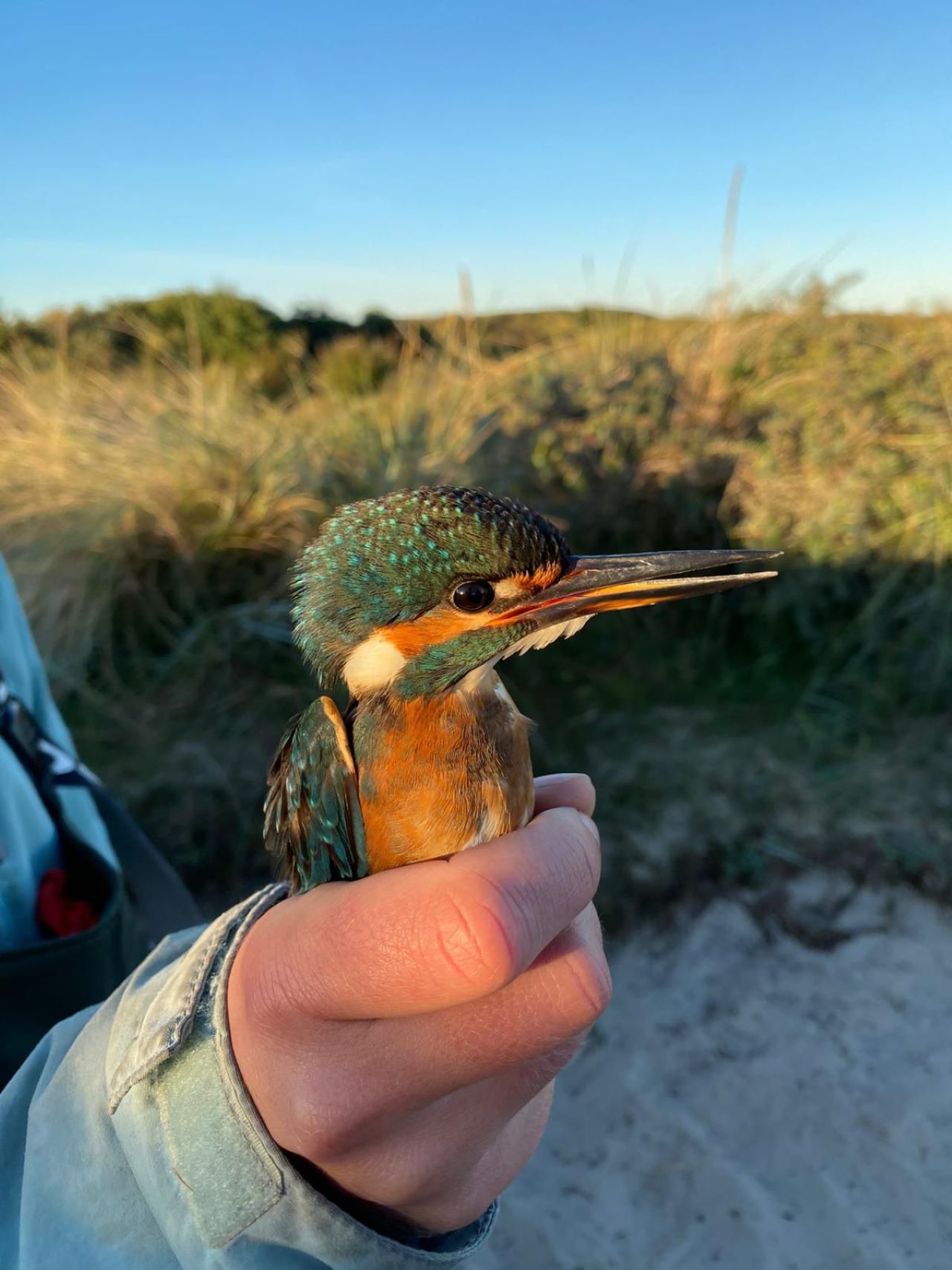
The Kingfisher (Isfugl) in hand. Photo by Gabriel
It was quite a slow migration day for us observers at Worlds End III. It was the second day in a row of sunny conditions with no wind and there were very few seabirds moving, though we did see 18 Graylag Geese (Grågås), 7 Red-breasted Mergansers (Toppet Skallesluger), and a Merlin (Dværgfalk). There was good passerine movement, but their movements continued to cause consternation for us counters. At one point, Gabriel commented that “this must be the largest roundabout in Northern Europe” because of all the passerines circling overhead and resting or attempting to migrate. Gabriel did detect another Ring Ouzel (Ringdrossel), several Red Crossbills (Lille Korsnæb), and 3 European Stonechats (Sortstrubet Bynkefugl).
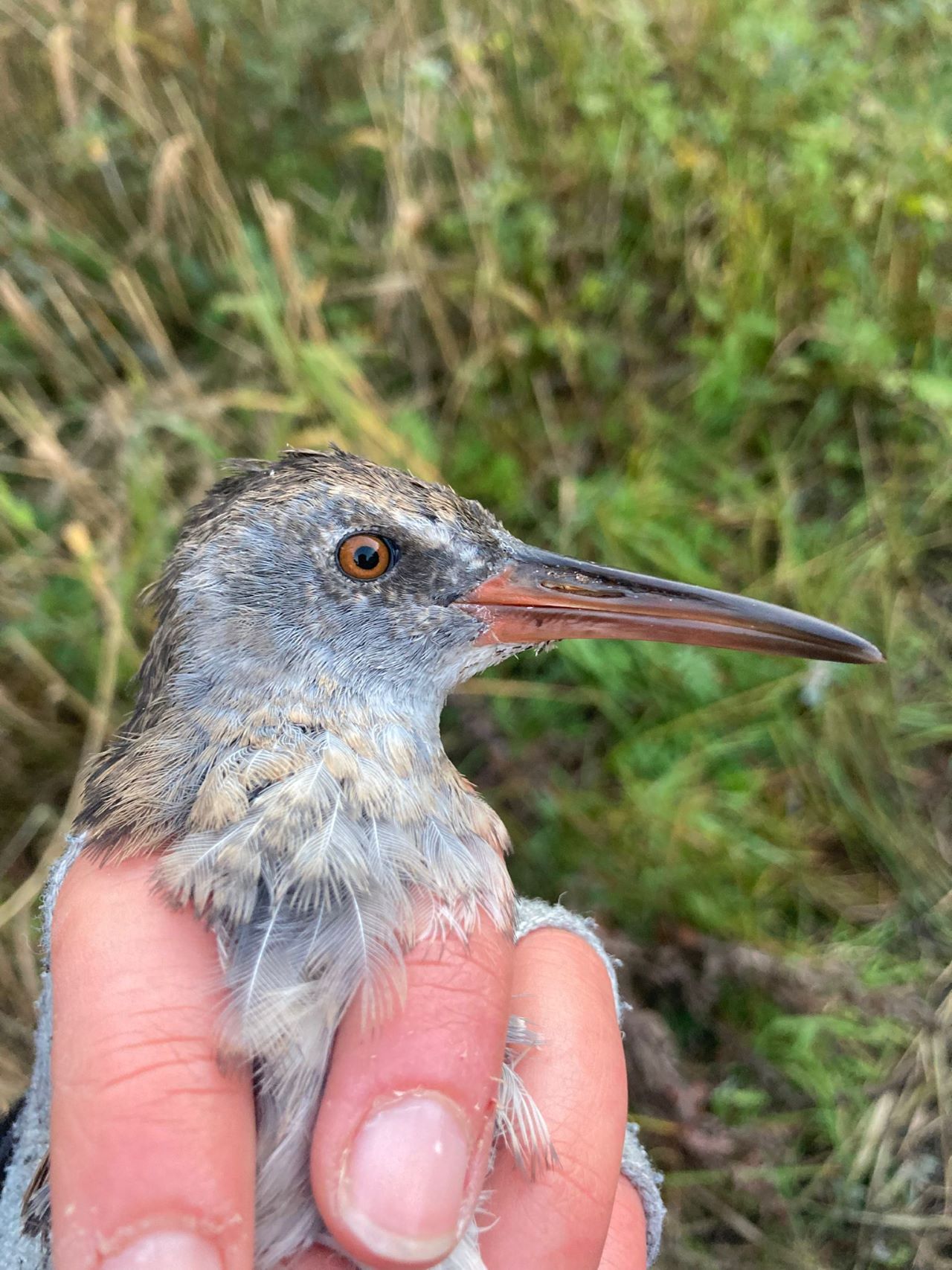
The Water Rail (Vandrikse) in hand. Photo by Amira
We have had a nice run of luck with kingfishers in the last few days. On Sunday, we found only the 44th record for Skagen while birding in the industrial area with Simon. This is now the 45th record for Skagen and the 9th time one has been ringed at the station (dating back to 2017).
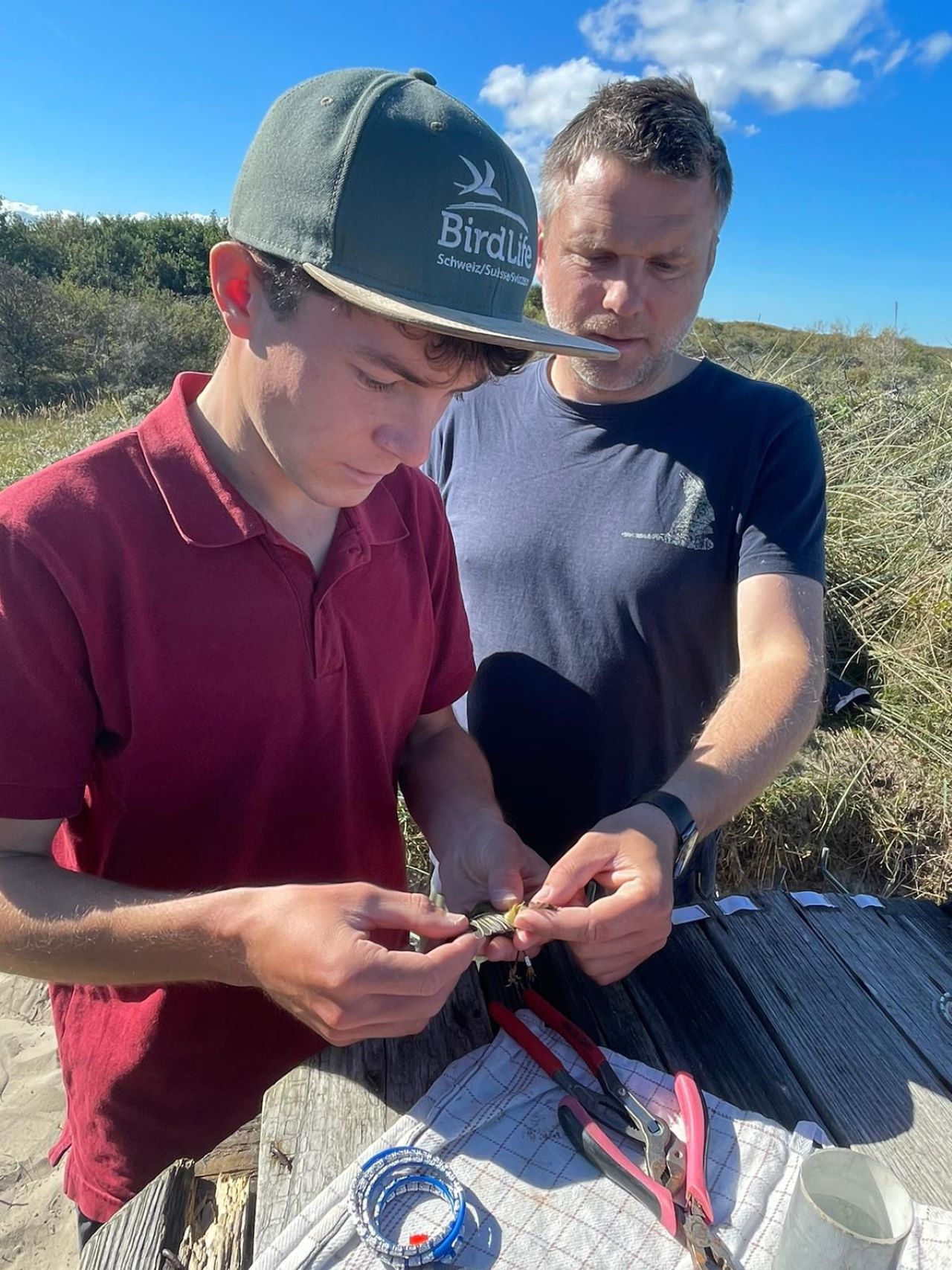
Simon showing Florian how to check molt progress in a passerine. Photo by Sarah
Last night we put up mist nets in the hopes of catching some storm petrels (stormsvale) but unfortunately did not catch anything, despite staying up checking the nets until past 1 AM.
This afternoon Sarah gave us all a tour of the station, including all the drawers, nooks, and attic. Prior to that, Gabriel spotted a strange bird down in the courtyard. It looked like a grackle and was about that size, dark overall but with a light patch on the face - maybe a funny escaped bird? When they went down to look for it, the bird had disappeared. Hopefully we are able to refind it tomorrow!
Ringing (Kabeltromlen):
Water Rail (Vandrikse) 1
Great Spotted Woodpecker (Stor flagspætte) 1
Song Thrush (Sangdrossel) 2
Eurasian Wren (Gærdesmutte) 5
European Robin (Rødhals) 5
Reed Bunting (Rørspurv) 2
Eurasian Blackcap (Munk) 6
Common Chaffinch (Bogfinke) 3
Eurasian Bullfinch (Lille Dompap) 3
Eurasian Blue Tit (Blåmejse) 8
Common Kingfisher (Isfugl) 1
Goldcrest (Fuglekonge) 29
Common Chiffchaff (Gransanger) 14
Total 80
Highlights from Worlds End III
Merlin (Dværgfalk) 1
Ring Ouzel (Ringdrossel) 1
List of today's observations in DOFbasen from the Skagen area
People: Gabriel Axelsson, Florian Hatt, Miles Scheuering, Amira Nuseibeh, Sarah Partridge, Simon Christiansen, Ole and Birgitte Jørgensen
Wrestling Wrens
There was another beautiful orange sunrise this morning at the start of the bird ringing session and it was the busiest morning of the Autumn so far with 103 birds in total! It was a big morning of Wren (Gærdesmutte) migration with 31 caught in the nets and many more calling from the bushes. Their call is actually one of the loudest for a bird of its size. It can reach 90 decibels which is as loud as lawnmower!
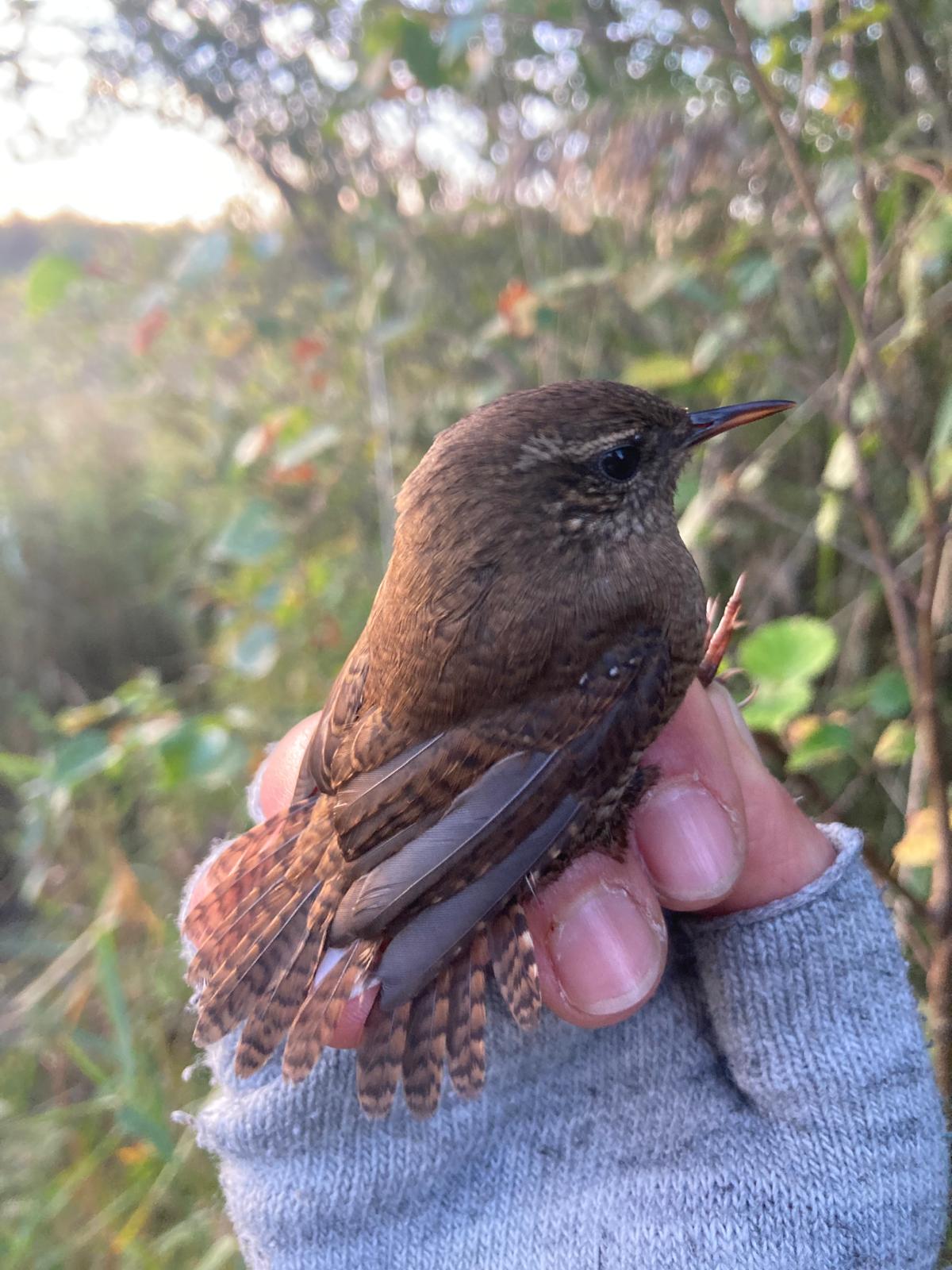
Wren (Gærdesmutte)
It was also super exciting to see two Ring Ouzels (Ringdrossel) which decided to hang out around the bird ringing station for a few hours. We tried to herd them into one of the mist nets but unfortunately they outsmarted us this time and, after snacking on some berries, they eventually headed off. The observers at Worlds End III also spotted a Ring Ouzel so I wonder if it was one of the same individuals we saw. Ring Ouzel are long-distance migrants which breed in northern and upland parts of Europe and then travel all the way to southern Europe and North Africa for the Winter.
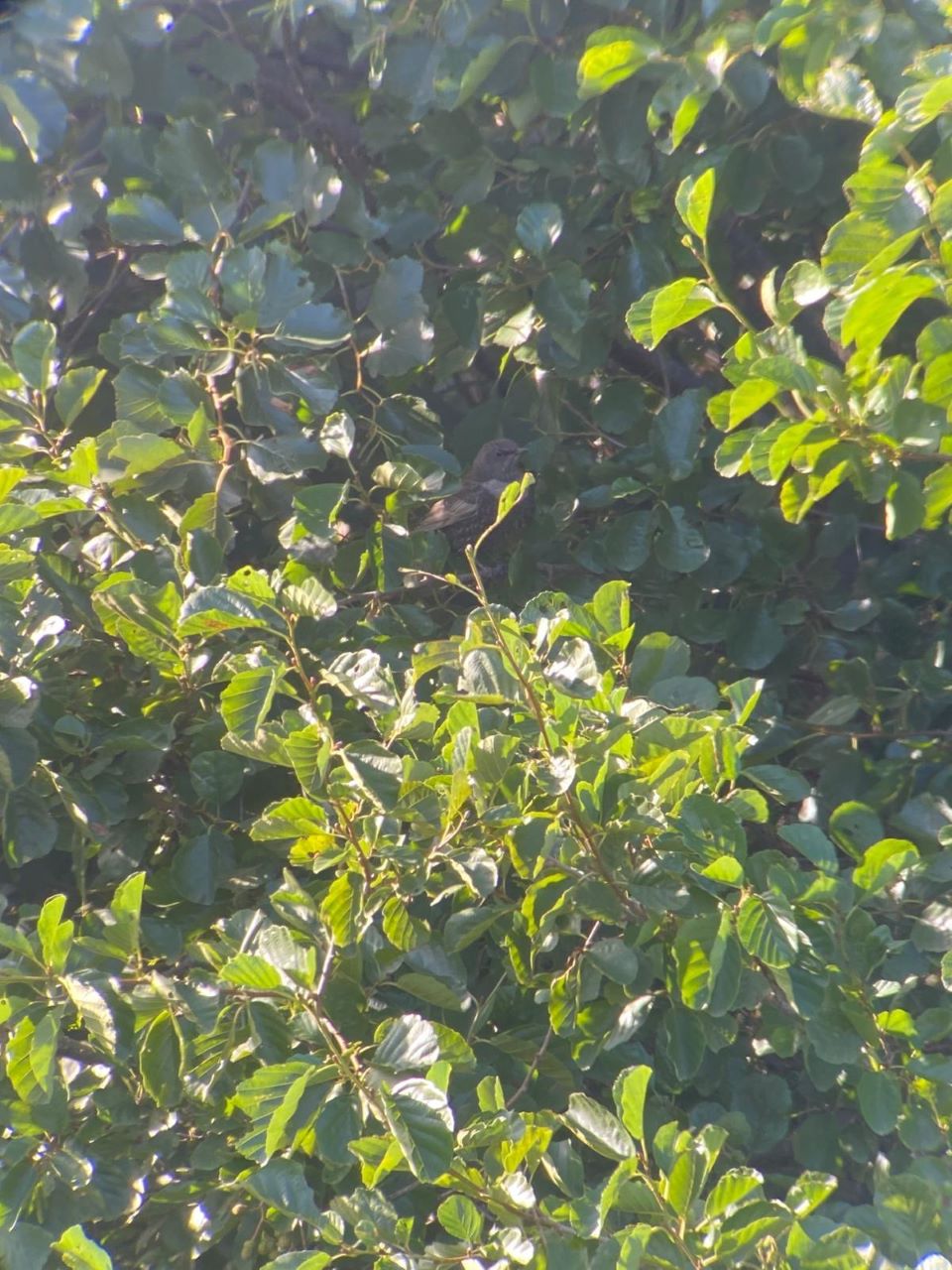
Ring Ouzel (Ringdrossel) in a bush. Photo by Gabriel Axelsson
I was also very happy to see my first Redwing (Vindrossel) of the Autumn migrating over us at Kabeltromlen. It won’t be long before they return in their thousands alongside the Fieldfare too! I can’t wait!
The observers (Miles, Florian & Sarah) also spotted lots of Redwings this morning from World End III, but the highlight for them was when the Orca (Spækhugger) made a surprise appearance. Although the Orca were quite far away, it was still incredible to see them surfacing and swimming around for almost an hour!
After our morning of ringing and observations, Sarah, Miles and I enjoyed our daily swim in the sea. The water was so clear and blue today, and we found two Starfish (Søstjerne) which was a nice surprise. Sarah, Gabriel and I stayed at home to catchup on some data entry and work whilst Miles, Florian, Simon and our guest Ole went back out for some birdwatching. They were really pleased to see five extremely beautiful five Black Redstarts in the industrial area.
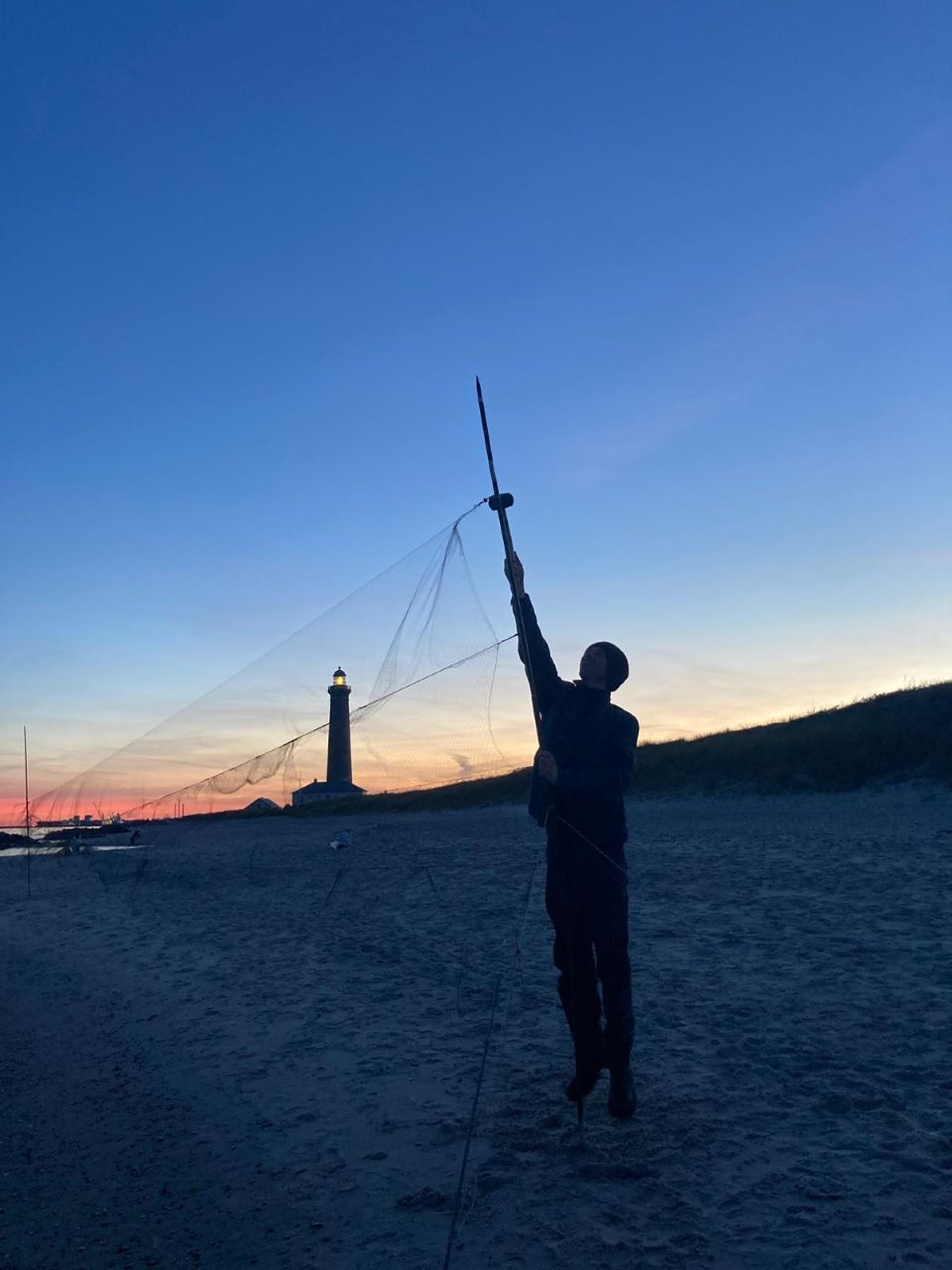
Setting up the mist nets to catch Storm Petrels (Stormsvaler)
Tonight, we will head out night catching in the hope of maybe finding one the Leach’s Storm Petrels (Stor stormsvale) which we have seen from Worlds End III in the last few days. But first Ole and Birgitte have cooked us a delicious dinner to warm us up and fill us with energy ready for the night ahead!
Ringing (Kabeltromlen):
Bogfinke 5, Gærdesmutte 31, Sortmejse 10, Rødhals 11, Musvit 5, Jernspurv 1, Rødstjert 1, Munk 10, Rørspurv 2, Blåmejse 4, Fuglekonge 16 , Gransanger 6, Træløber 1
Ringing (Jennes Sø)
Gærdesmutte 2, Rødhals 2, Solsort 1, Gransanger 1, Fuglekonge 5, Blåmejse 1, Musvit 2, Bogfinke 1, Gråsisken, Lille (ssp. cabaret) 21
Total new birds: 118
Highlights from Worlds End III:
Ring Ouzel (Ringdrossel) 1
Redwing (Vindrossel) 17
Black Guillemot (Tejst) 1
Orca (Spækhugger) 5+
Link to today’s observations in DOFbasen from the Skagen area
People: Gabriel Axelsson, Florian Hatt, Miles Scheuering, Amira Nuseibeh, Sarah Partridge, Simon Christiansen, Michael Ancher, Ole Kristjansen, Lisa Vergin, Ole and Birgitte Jørgensen.
Loon or Lunatic?
Today was very cold in the morning and we were all a bit sleepy after the excitement of night catching last night, but Amira and I still woke up excited for ringing to see what we will catch in the nets. It was a busy morning with many birds in each round, and good thing Simon was there to help us pick up the pace with so many birds. We saw all of Skagen’s CUTEST birds in the nets today: Treecreepers (træløber), wrens (gærdesmutter), and goldcrests (fuglekonge). We also had the first Brambling (Kværkerfinke) of the season which Amira was very happy about.
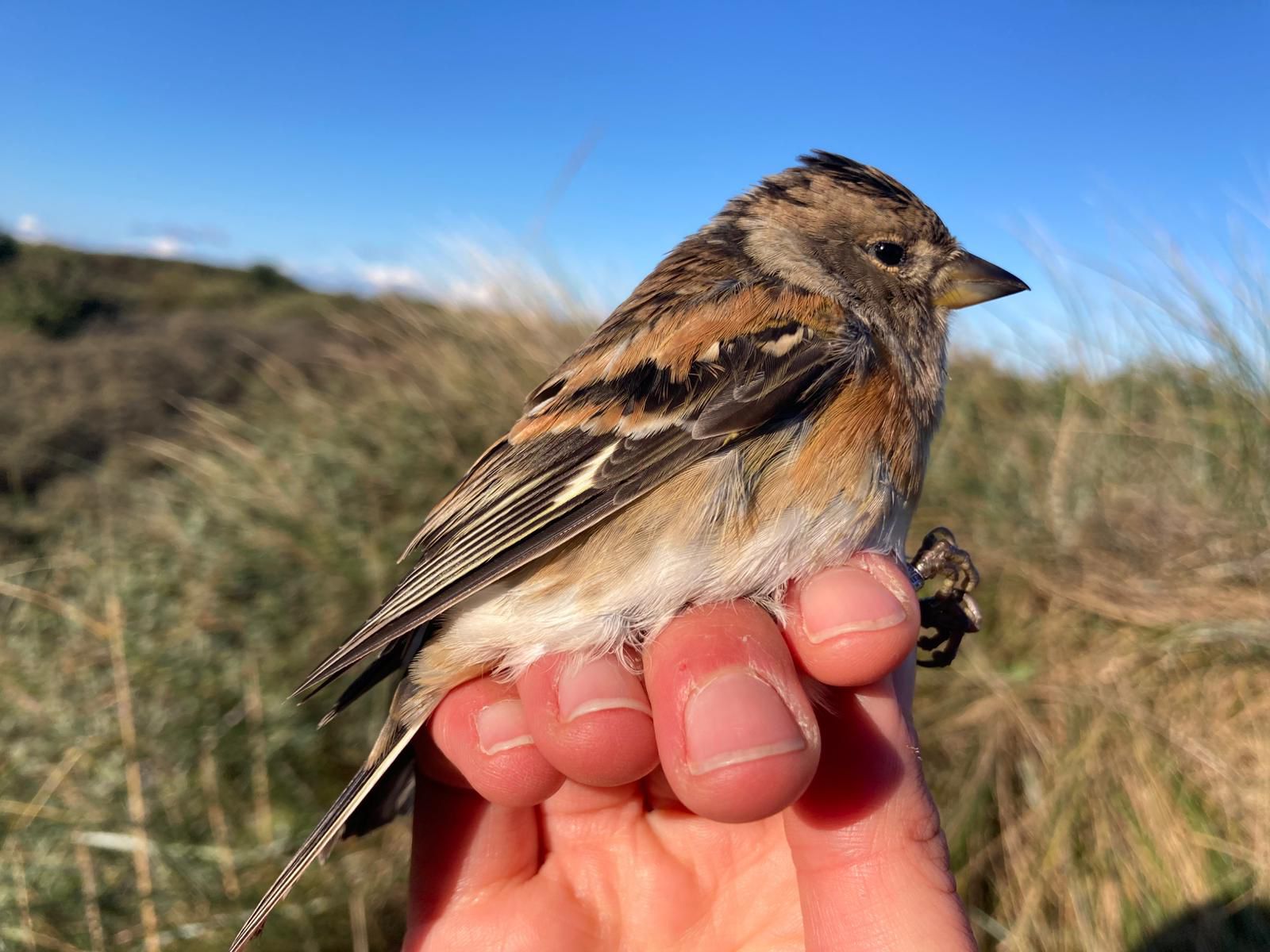
First brambling (Kværkerfinke) of the season
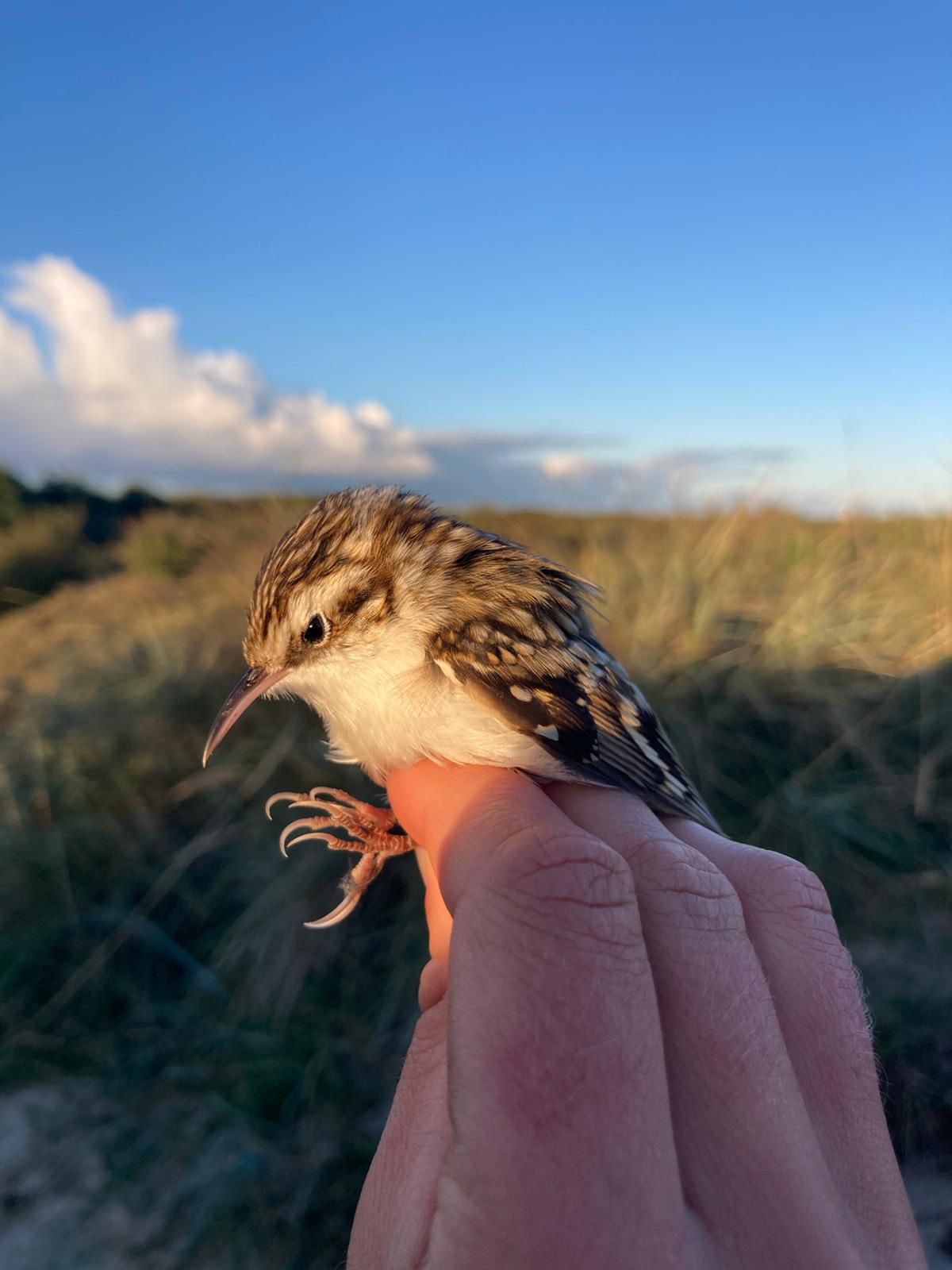
One of the outrageously cute treecreepers (Træløber)
Meanwhile, Florian, Gabriel, and Miles were at World’s End III with Knud for the observation, where they also had a very busy day! We could hear them over the radio calling out birds regularly throughout the morning, and we were also luckily able to see two of their four sooty shearwaters (Sodfarvet Skråpe). They also saw yet another Leech’s storm petrel (Stor stormsvale) but with a better look than yesterday. This one we could not see from Kabletrommeln.
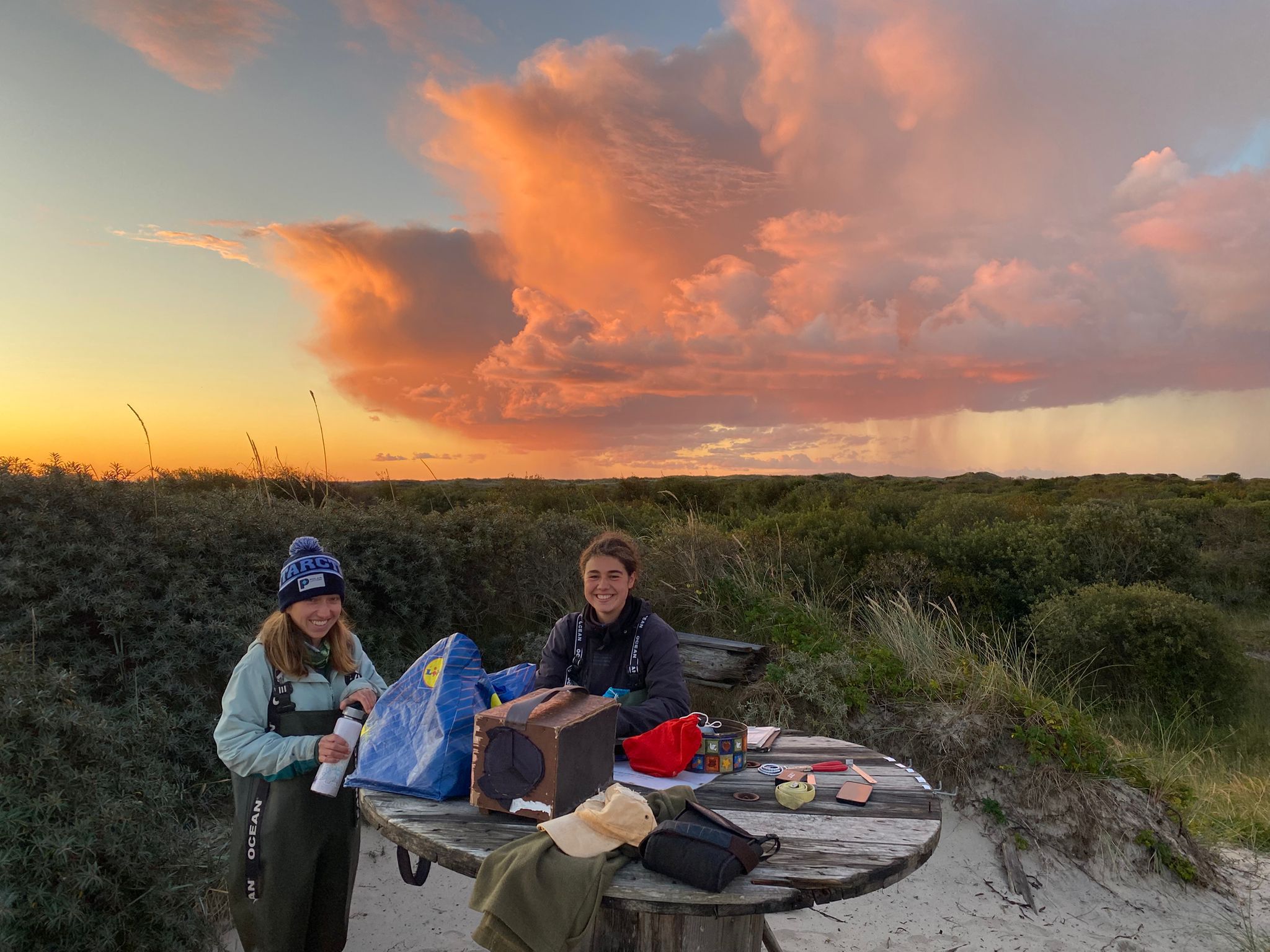
Amira and I got back a bit late from ringing after the busy morning, and then went for a very cold swim. Miles also joined us after his first run of the season. After a pleasant afternoon of napping, birdwatching, and various other bits, we joined together for a tasty mediterranean meal from Florian. We learned some new information about Swiss people; they eat their fondue very frequently and with high stakes—the rules vary, but it's never good if someone drops a piece of bread off the fork.
The Red-throated Loon (Rødstrubet Lom) from yesterday was a very cool catch and only the second one to be ringed here at the observatory. We almost missed it because Simon didn’t want to get his feet wet, but luckily Lisa was there to quickly talk some sense into him. It was an adult bird moulting its flight feathers, meaning it will stay here for a while until it can grow the new feathers and fly away again. Birds with shorter wings compared with body size (such as ducks, divers, and auks) are more likely to have this strategy of moulting flight feathers all at once, because their wings need to carry proportionally more weight, so losing one feather at a time is more costly. Therefore it is better for them to risk being flightless for a short period of time and retain all of the flight feathers and maximum function for the rest of the year. We hope this beauty will have a pleasant stay and a safe onward journey.
Highlights from Grenen:
Sooty shearwater (Sodfarvet Skråpe) 3
Leech’s storm petrel (Stor stormsvale) 1
Great skua (Stor Kjove) 5
Long-tailed skua (Lille kjove) 1
Fulmar (Mallemuk) 126
Ringing (Kabeltromlen):
Musvit 3
Munk 13
Gærdesmutte 20
Rødhals 5
Jernspurv 4
Lille Gråsisken 1
Rødstjert 1
Rørspurv 2
Kvækerfinke 2
Bogfinke 6
Gransanger 5
Trælober 5
Fuglekonge 18
Total new birds: 85
Ringing (Jennes Sø):
Gærdesmutte 4
Rødhals 4
Gransanger 5
Fuglekonge 11
Topmejse 1
Blåmejse 2
Musvit 1
Træløber 1
Lille Gråsisken 27
Rørspurv 1
Storm Petrel, Diver and Jewish New Year
Today was a cold day. The wind came from the northwest, and it was about 5°C colder than the last days. The wind was too strong for ringing, so Sarah, Amira, Miles, Florian and I biked out to Worlds End III to do some migration count instead. Once there we met up with Knud, as usual. Not long after, Ole (one of this week’s guests) also joined us. One of the highlights of the day was a Leach’s Storm Petrel (Stor Stormsvale), first spotted by birders at Worlds End I, and soon after we saw it too. You could really tell the cold winds were bringing in some new birds for the season. We had the first Snow Bunting (Snespurv) and Horned Lark (Bjerglærke) of the autumn, and about 30 migrating Pink-footed Geese (Kortnæbbet Gæs), which was nice to see. After the count, Florian, Miles and I checked through the Reed Buntings (Rørspurv) resting in the sea buckthorn along the beach. We counted around 150 Reed Buntings (Rørspurv), but not much else.
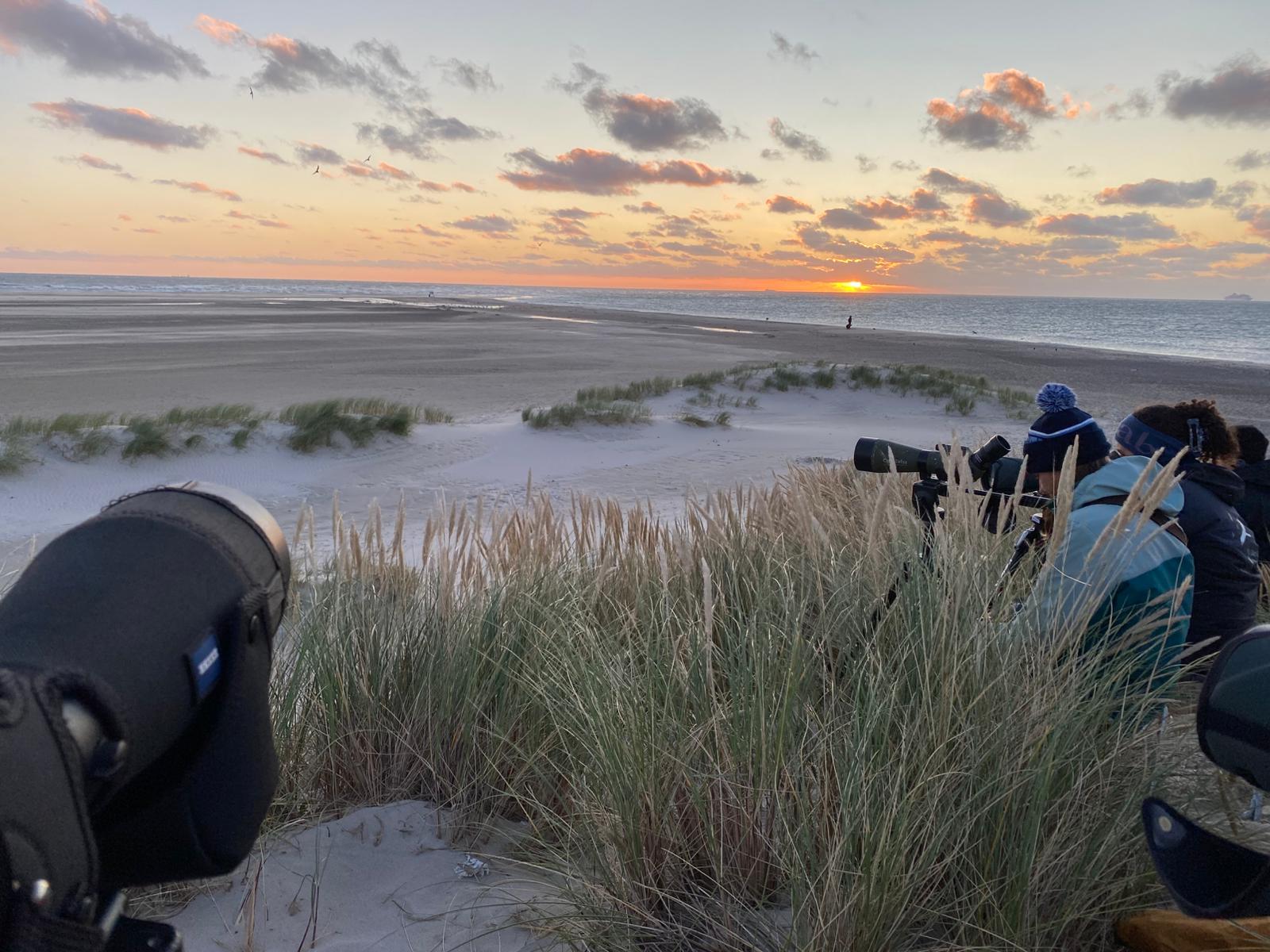
In the afternoon some of the team went for a cold swim in the sea, and later we all helped cook dinner, which Sarah had organized. Dinner or “The Feast,” as Sarah called it, was themed around the Jewish New Year, which is today. We enjoyed the meal together with the whole volunteer team, Simon, Lisa, Mette and our guests Ole and Birgitte.
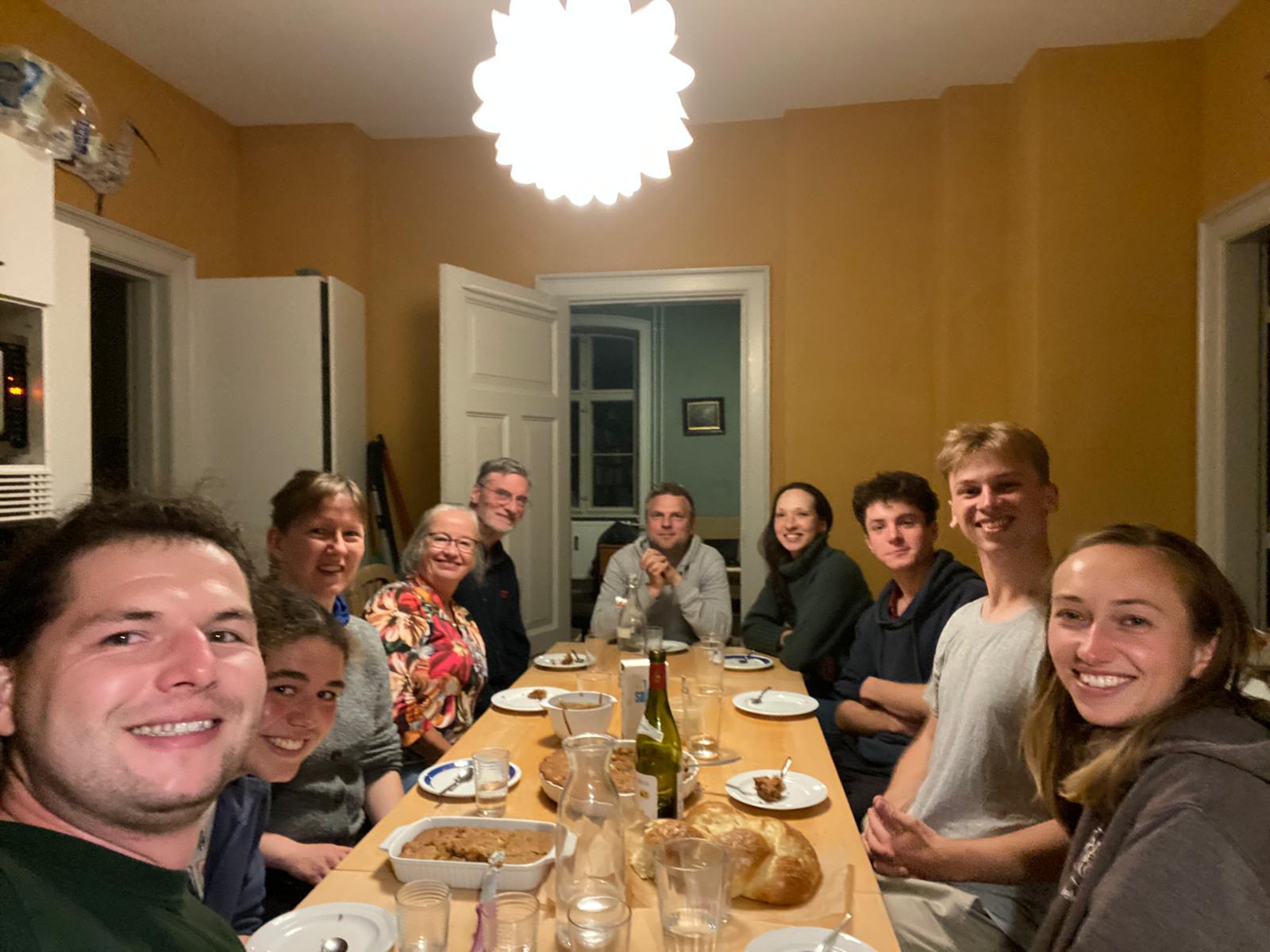
Shana tova
After dinner some of us went out for nightcatching. Simon, Lisa and Florian walked along Grenen’s south beach, while Amira, Miles and I covered the north beach. Unfortunately, my team didn’t catch anything, but luckily the other team caught two Dunlins (Almindelig Ryler) and amazingly, a Red-throated Diver (Rødstrubet Lom)! Everyone was very excited to see the birds up close and especially the diver.

Red-throated Diver (Rødstrubet Lom)
Ringing (Jennes Sø):
Gærdesmutte 1
Rødstjert 1
Munk 1
Gransanger 4
Fuglekonge 3
Blåmejse 2
Musvit 3
Lille Gråsisken 8
Highlights from Worlds End III:
Stor Stormsvale 1
Snespurv 1
Bjerglærke 1
Kortnæbbet Gås 36
Links to todays observations in Dofbasen from the Skagen area
People: Gabriel Axelsson, Florian Hatt, Miles Scheuering, Amira Nuseibeh, Sarah Partridge, Simon Christiansen, Lisa Vergin, Knud Pedersen, Michael Ancher, Ole and Birgitte Jørgensen.
Skuas and a surprise in the heath
Shortly after the rain stopped in the morning, Miles and I headed to Worlds End III just in time for sunrise. The wind blew strongly from the southwest, but that didn't stop us from counting everything and being motivated to search for rarities. Knud supported us again this morning. We were actually rewarded with a good number of skuas. It was really nice to see again a Great Skua (Storkjove), a juvenile Long-tailed Skua (Lille Kjove) and once, three Arctic Skuas (Almindelig Kjove) flying together. Once again, good numbers of Kittiwakes (Ride) made today's migration count exciting. Our hearts sometimes skipped a beat when juvenile individuals in the distance strongly resembled Sabine's gulls (Sabinemåge). However, we didn't see any of those today. A young Mediterranean Gull (Sorthovedet Måge) roosted on the beach though.
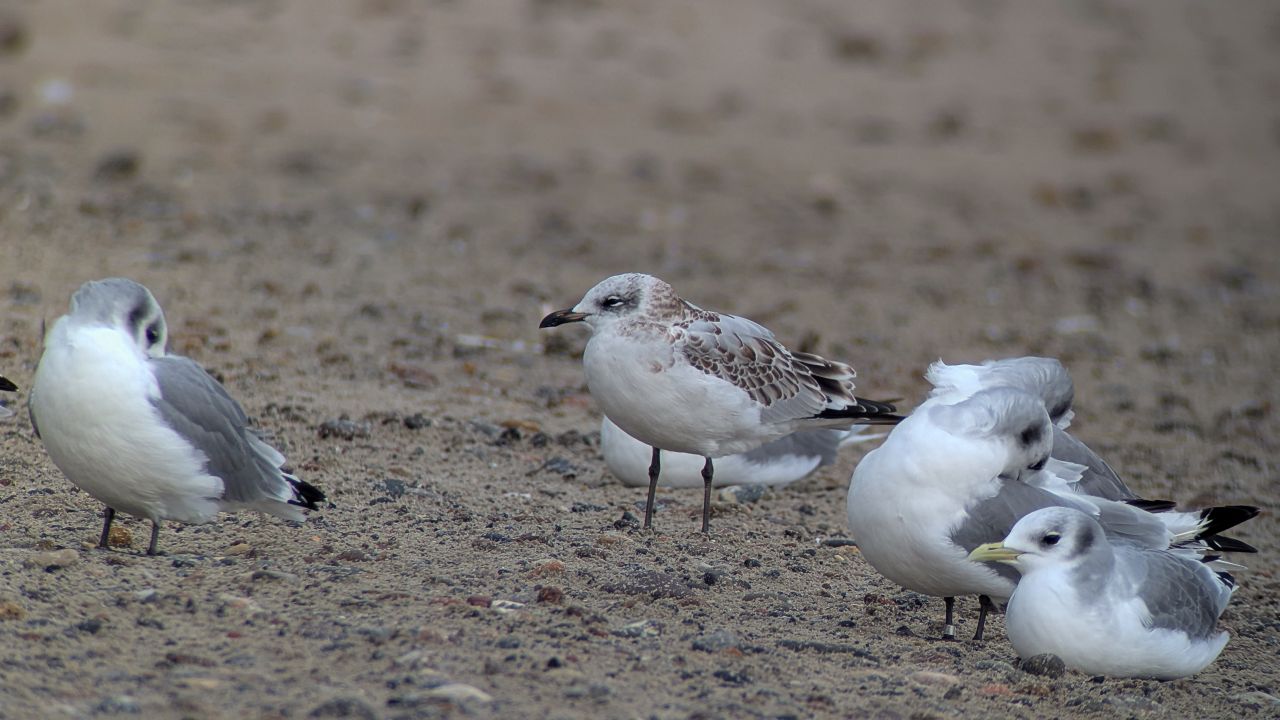 1 cy. Mediterranean Gull (Sorthovedet Måge) together with Kittiwakes (Rider). Photo: Knud Pedersen
1 cy. Mediterranean Gull (Sorthovedet Måge) together with Kittiwakes (Rider). Photo: Knud Pedersen
The passerine migration is gradually increasing the last days. The many resting and attempting to migrate reed buntings were difficult to count, but also nice to watch. Another nice passerine was the well-known Citrine Wagtail (Citronvipstjert), which Simon was able to observe briefly today at the parking lot before he went to do the ringing. Due to the wind, they started ringing a little later and did not open all the nets today. That's why there were very few birds in the net today.
After the migration count, Miles and I searched again for the Citrine Wagtail (Citronvipstjert) and checked Ellekrattet for some passerines but both not really successful.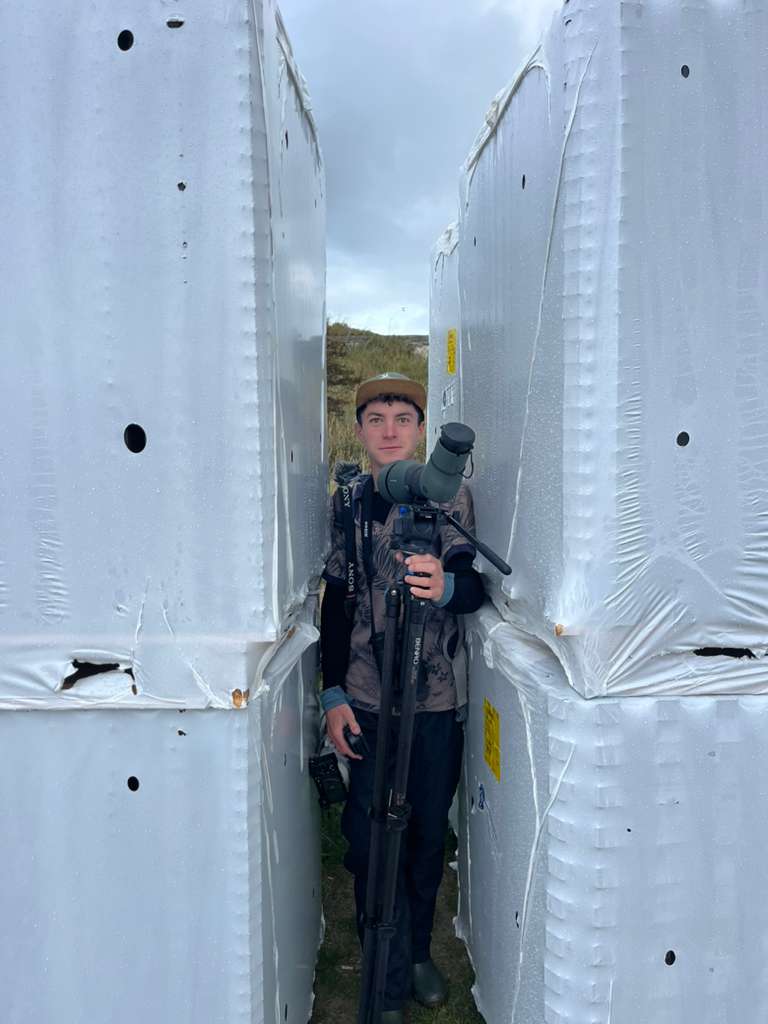
Florian searching some shelter from a rain shower while searching for the Citrine Wagtail
In the afternoon, Simon took us by car to see some good birding spots around Skagen.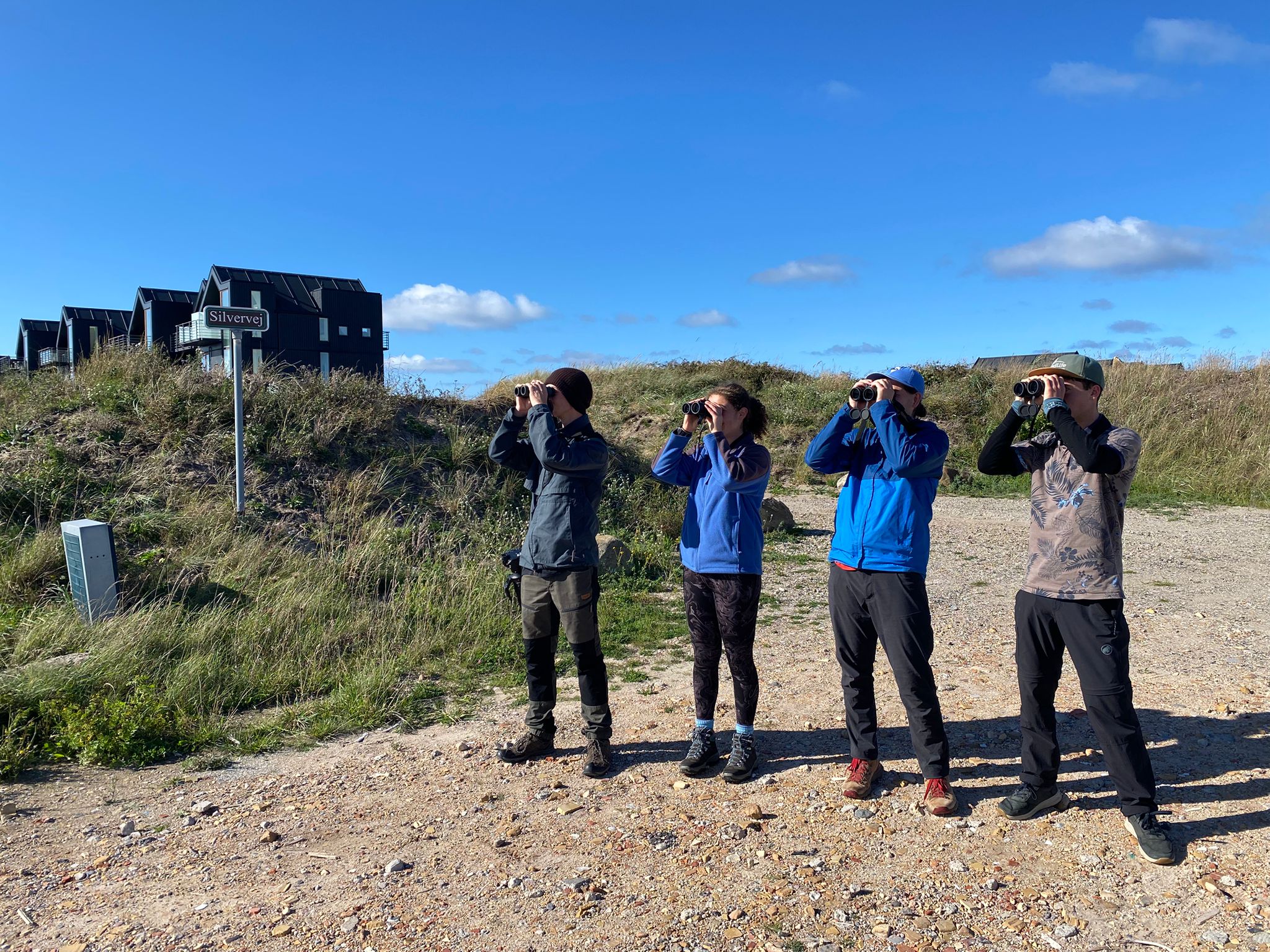
Birding in the industrial area
A very unexpected sighting was a Kingfisher (Isfugl) flying over the heath east of Højen Fyr! It’s only the 44th record in Skagen. We also checked some bushes, which resulted in a few lifers for Amira and Miles! Very successful, I would say!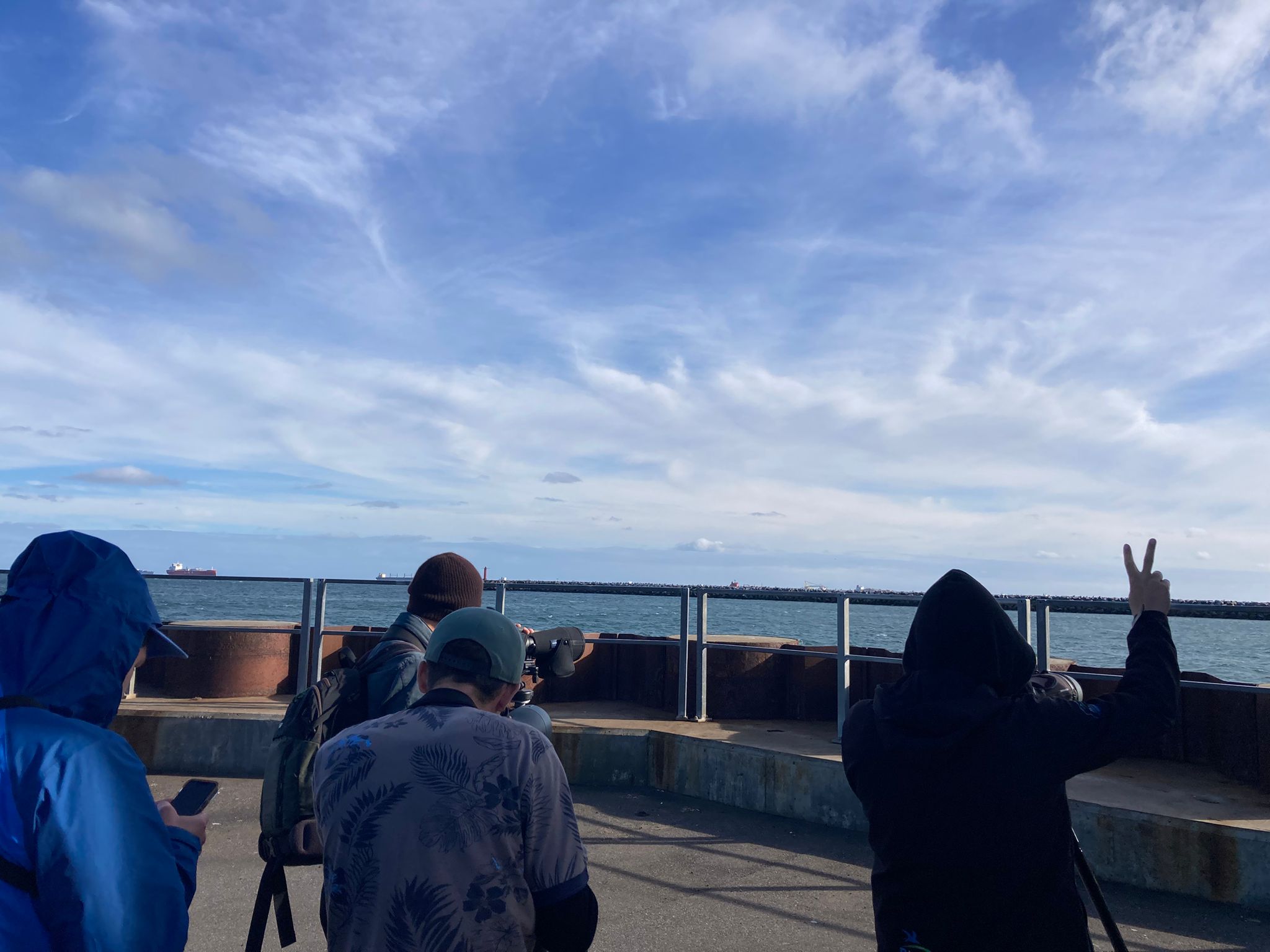
Simon greeting some norwegians on a boat at the harbour
Back at the house, we welcomed our new guests Ole and Birgitte, who joined the evening meeting. Afterwards, Miles cooked a delicious dinner for us.
Ringing (Kabeltromlen)
Rødhals 2
Munk 7
Gransanger 2
Total 11
Ringing (Jennes Sø)
Blåmejse 2
Gransanger 3
Munk 2
Gærdesanger 1
Rødhals 1
Jernspurv 2
Grønsisken 2
Gråsisken, Lille (ssp. cabaret) 7
Total 20
Links to todays observations in Dofbasen from the Skagen area
People: Gabriel Axelsson, Florian Hatt, Miles Scheuering, Amira Nuseibeh, Simon Christiansen, Knud Pedersen, Michael Ancher
